#this is most clearly illustrated with stacy.
Explore tagged Tumblr posts
Text
the best part about house md is that house is a stupid ass name
#this is most clearly illustrated with stacy.#can you imagine. STACY HOUSE. i literally wouldnt get married at that point#(also i do know he gets married to someone else at some point but ive only watched through s5 lmao)#butch otter notes#house md#hate crimes md#hatecrimes md#greg house#gregory house#dr house
545 notes
·
View notes
Text
Most Common Problems Faced by My Childhood Dolls (Grouped by Type of Doll)
Baby/Companion Dolls: life-threatening diseases; bullying by other dolls at school; my dubious discipline style; my divorce from my imaginary husband Jake.
Groovy Girls: bullying by other Groovy Girls; life-altering gymnastics accidents; feet too unwieldy for go-go boots.
Barbies: false witchcraft accusations; real witches; tuberculosis; kidnapping; the time Ken and his brother Adam started a polygamous cult; bullying by other Barbies (whether in a normal high school or a beauty pageant or a cult); basically anything bad that happened to female movie stars in Hollywood under the studio system; the challenges of raising a million Chrissies and Kellies and Stacies and Skippers and similarly sized off-brand child dolls with little help from Ken or Adam; sibling rivalry (including an East of Eden-style mess between Ken and Adam).
Dollhouse Families: my friend Emily C. (I was Emily S.) stealing the mom doll from my old Fisher-Price family, leaving John (the dad) a widower, so when I got a new family a few years later, I decided that John should marry Patricia, the mom of the new family, which made it necessary for me to interpret Robbie (almost certainly meant to be a dad doll) as Patricia's teenage son, which was obviously very emotionally confusing for Robbie and exacerbated the usual tensions of a newly blended family.
Clothespin Dolls: Nancy, Alice, and Lily, the three charming clothespin dolls made by my genuinely talented great-aunt Beth in the 1960s or 1970s, were grown-up sisters who had a complicated dynamic (both Nancy and Lily had serious psychological and/or substance abuse issues, so Alice had to take care of them and Nancy's children and her own children) and also experienced nineteenth-century-literature-style problems, like diphtheria and ice-skating accidents and bear attacks. The clothespin dolls that I created myself as a tween/young teen were not as well-made, but their problems were generally limited to normal high school bullshit (not even the kind where you get poisoned or kidnapped!).
Miscellaneous Medium-Sized Figurines (mostly fast food toys of Disney characters and mini-Barbies): various passive-aggressive rivalries between groups (mini-Barbies vs. movie/TV characters, Disney vs. non-Disney, movie vs. TV, protagonist vs. non-protagonist, etc.); a lack of eligible bachelors (leading to unwise marriages, such as Belle from Beauty and the Beast marrying a temperamental Space Jam monster); ennui.
Playmobils: the Playmobils had a nearly utopian society, relatively free from poverty and class snobbery, and generally this diverse group of Union soldiers, stuffy Victorians, pirates, outlaws, royalty, horse girls, milkmaids, and fairies were able to work out their differences peacefully. However, all that progressive modernity had a dark side, most clearly illustrated by the Kafkaesque ordeal of Oliver, a boy who was imprisoned for no discernable reason by an evil psychiatrist and his social worker girlfriend despite the desperate efforts of his mother to free him. Intense wartime romances and infectious disease outbreaks were also common themes.
Fisher-Price Great Adventure Action Figures: these rather hideous but very fun toys (consisting of an anachronistic mix of knights, pirates, cowboys, and Robin Hood's Merry Men) belonged to my seven-years-younger brother, so we would play with them a lot while I was looking after him. Naturally there was a lot of military conflict and criminal activity built into our play (will Robin Hood and his friends be able to steal the treasure from the castle? Will the golden knights or the black knights win the big battle? Who will stop the stagecoach robberies?), but, to entertain myself, I would introduce storylines such as "the Golden Sword Knight is tired of being bullied by the other knights, so he runs away and goes to live in the forest with Robin Hood's gang, where he falls in love with a female outlaw" and "Little John starts a AC/DC-style rock band with two of the black knights and everyone hates it."
Fisher-Price Little People: easily the most provincial of the doll groups, the Fisher-Price Little People struggled with extreme class/wealth inequality, widespread adultery, child abuse, teen homelessness, practically non-existent resources for the disabled, sexual repression, a character known only as "The Pervert," and a killer clown. Every day they went to school and work, and every night they tried to find someone to hook up with and maybe got kidnapped. I only wish my brother and I had been in possession of the motel playset. Think of all the extramarital affairs and drug deals that could have happened there!
Polly Pockets: the Polly Pocket community was dominated by two wealthy factions, a nouveau riche pair of brothers with a beach party house and the royal family. Due to a severe job and housing shortage, plus the local men's habit of not acknowledging their natural children, ordinary Polly Pockets had to struggle and scrape. Compared with the Barbies, there was a lot of solidarity among women (and also Josh, the one working-class boy Polly Pocket). Many of the Polly Pockets were very fragile, including the alcoholic Cowgirl Becky and the agoraphobic piano player Penny.
Paper Dolls: intense status jockeying over who had the most/best clothes, mainly. They also fought about friendships and (if there were any of them) boys, but it ultimately came down to clothes.
#dolls#little john's signature song was called 'ride to hell'#'we're going along on a ride to hell/why don't you come along and feel the trail'#it was not good and everyone was so mad at him
155 notes
·
View notes
Text
The Problem with Spidey as ‘Iron Man Junior’
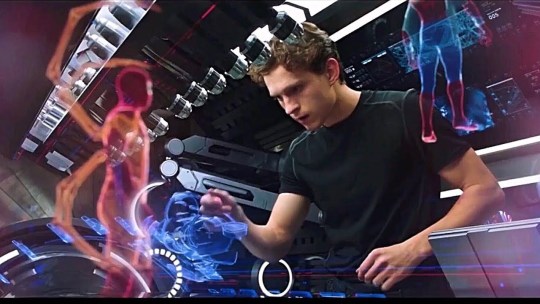
Proponents of the MCU version of Peter Parker have often defended his characterization as logical and necessary in context. But is this really the case?
Tl:dr version: No it is not.
Forgive some laziness on my part because I’m going to be presuming everyone’s familiarity with the comic book iteration of Spider-Man and his MCU adaptation for the most part. To say there is a divide between many fans of former vs. the latter would be an understatement.
Detractors (which I count myself among) typically sum this up as the character being reduced to ‘Iron Man Junior’. In general this refers to MCU Peter Parker’s hero-worshipping of Tony Stark/Iron Man, their father/son relationship and the similar emphasis upon high technology in their hero identities. A connected point of contention is Peter’s aspiration to become an Avenger.
This was outright confirmed by Tom Holland himself in an interview for the then upcoming ‘Spider-Man: Homecoming’.
"I think the difference now is that Peter Parker finally has an all-time goal, and his goal is to become an Avenger…Everything he does, even though he's doing it for the right reasons, is done so that one day he can become an Avenger and prove himself to Tony Stark. And I think we've never really seen Spider-Man with that kind of motivation before."
Defenders of this take upon Spidey have argued that this portrayal makes sense in context.
After all, Peter Parker is a teenager who’s grown up in a world where the Avengers are beloved, especially Iron Man. Plus in the comics (under J. Michael Straczynski’s pen) there was a time when Peter and Tony shared a father/son relationship. Tony even equipped Peter with a high tech costume as he did in the MCU. Spider-Man early in his career attempted to join the Fantastic Four in ASM #1 and later the Avengers in ASM Annual #3.
The problem is these defences just don’t hold up to scrutiny.
Let me first be upfront about my philosophy towards adaptations.
I in no way shape or form demand nor expect adaptations to be 1:1 panel to screen translations of the source material. I fully respect that changes are a necessity.
One of many 22-page comic book stories put out every month in the 1960s inevitably needs to be altered when jumping to a 90+ minute live action film in the 2010s.
Even the characterizations need to be altered where necessary if the source material is found wanting. *side eyes Emma Stone’s Gwen Stacy*
However, my attitude is that adaptations should at minimum respect the spirit of the source material no matter what. To do otherwise defeats the object of adapting the work in the first place. If a film is just borrowing superficial traits (names, costumes, powers, etc.) and but not representing the spirit of the character, then creatively speaking it might as well be an original character.
This is the case with the MCU version of Spider-Man. A fundamental component of Stan Lee and Steve Ditko’s original vision for Spider-Man was that he was in essence the anti-Robin.
At a time when teenaged characters were sidekicks (Dick Grayson), supporting characters (Rick Jones) or the ‘kids’ in teams (Johnny Storm) Peter Parker was unique as a totally independent teen hero. Of course that independence only applied to his life as Spider-Man, but that was part of the point. Spider-Man was his escape and release from the pressures and hang ups of his regular life, which included his doting yet coddling aunt.
A critical part of this was that he was a self-made man. No elder mentor guided him in the use of his powers, helped him create his equipment or provided any sort of advice/accountability for Peter. He did it all himself. He was a loner.
On a meta level this is partially why Stan Lee (and for the longest time consequent writers) showcased Spidey not jiving with super teams. It was done to emphasis Peter’s independence and thereby his uniqueness within the genre. Even if that’s not so unique anymore (even in film), it’s still a baked in component of teen Spidey’s story. An essential aspect of who he is as a character.
As is his working class status.*
In fact these things go hand-in-hand. Just as Peter had to shoulder an ‘adult hero’s’ burden as Spider-Man (noticeably Lee didn’t dub him Spider-Boy or Lad as would’ve been common back then he also had to struggle for every penny. With the death of his uncle and his aunt’s poor health the burden of household provider fell on his shoulders.
When you take all this into account, having him fanboy over the Avengers and have a superhero mentor (let alone a billionaire one) is an aggressive misreading of the character.
The best way I can illustrate this is with an analogy from the opposite end of the spectrum. Imagine if you will a movie depicting Dick Grayson’s transformation into Robin. Except Batman was wholly absent. Not even an off-screen presence.
That is how poorly MCU has missed the point of Spider-Man.
And it was never necessary.
Contrary to defenders of the MCU, making Peter an Avengers/Iron Man fanboy was not the only logical direction to go with the character.**
Yes, in Peter’s world most kids would revere the Avengers and Iron Man. But in the real world not every kid or teen likes the Avengers characters or movies. Just as not every major pop culture phenomenon has ever been universally embraced by contemporary kids/teens. In the 1980s not every kid loved the Transformers or the Ninja Turtles. In the 1990s not ever kid loved the Power Rangers or Pokémon.
Of course, most kids did, just as most kids like the Avengers characters today. Similarly most kids in the MCU by extension would look up to the Avengers. However, if anything this could actually help generate a more spiritually faithful rendition of the character. Consider that on literally the first page of Amazing Fantasy #15 Peter Parker was mocked by his classmates for being an outsider. A bookworm who didn’t know the difference between a cha-cha and a waltz.
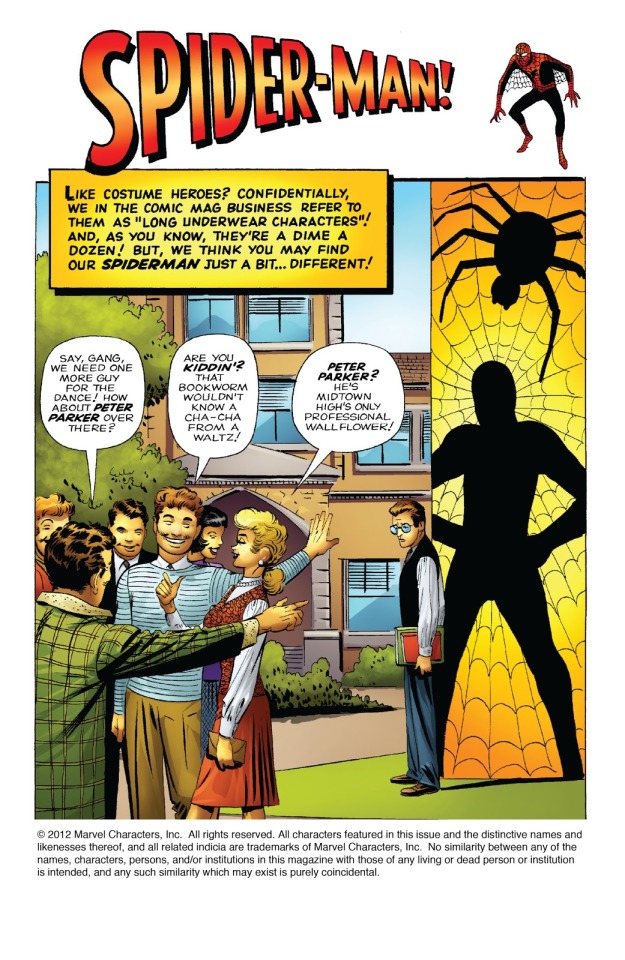
In the context of the MCU wouldn’t Peter’s lack of familiarity or interest in the Avengers make for an appropriate updating of that characterization?
Let’s also consider that in the context of the regular 616 universe Spidey held little reverence for any of the heroes who had preceded him. This included Captain America and other WWII heroes as well as the Fantastic Four and their leader, the world famous scientist Reed Richards. Peter would’ve surely known who Reed and Cap were but as originally depicted by Stan lee himself, he wasn’t falling over himself during any of their early encounters.
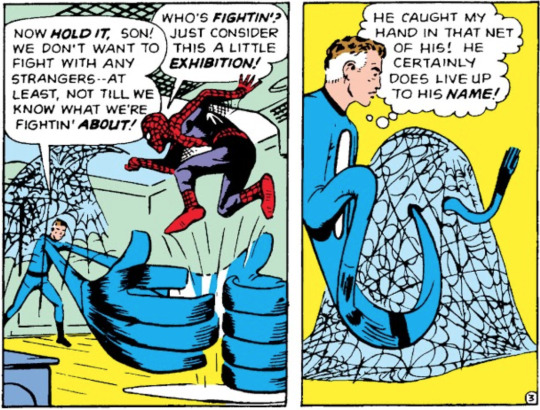
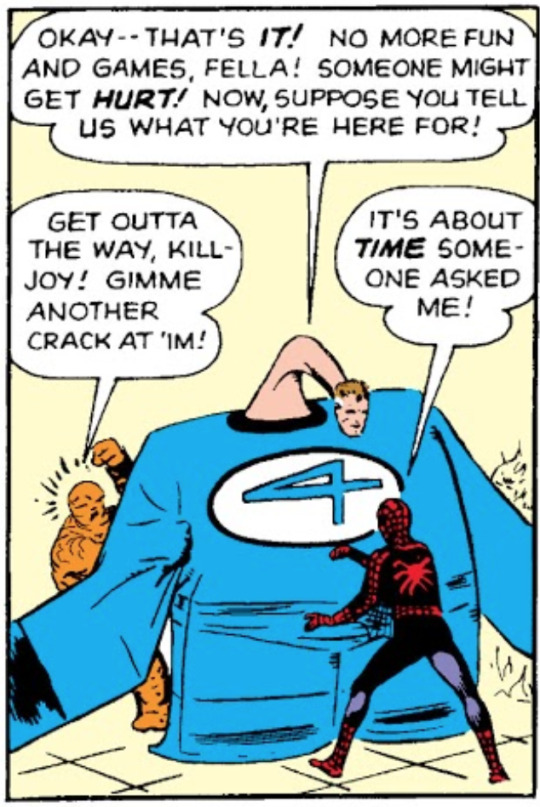


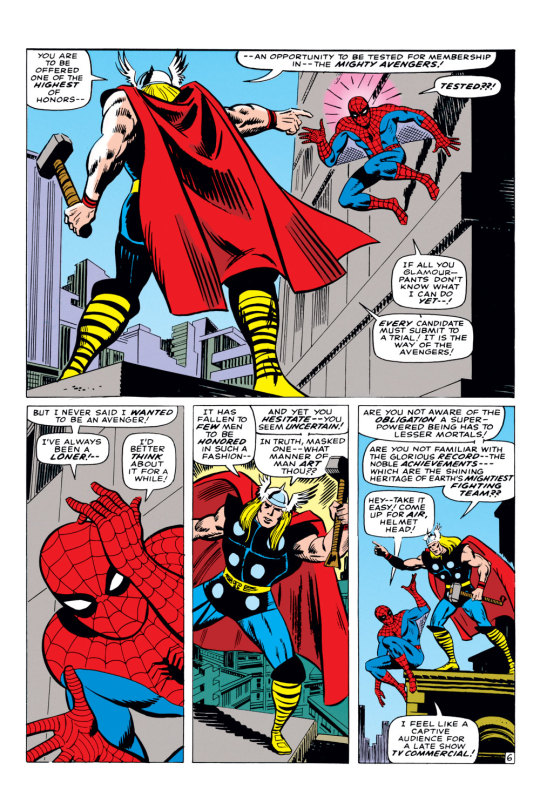


So there was already a precedent in the comics for Spidey to not be dazzled by famous A-list heroes, meaning it’d be totally believable in the context of the MCU. Indeed this was likely part of the point of the character. Just as being Spider-Man didn’t improve his outsider status within the high school hierarchy so too was he an outsider among his super hero peers. The nerd to the Avengers jocks if you will.
But what of those comic book sources that say otherwise? Surely ASM #1, ASM Annual #3 and JMS’ run on Amazing Spider-Man corroborate the MCU’s take upon the character.
Yes and no, let’s tackle them one by one.
In ASM #1 it was made explicit that Peter wanted to join the F4 for purely practical reasons. His family needed money so he hoped the F4 could provide and income. When he learned otherwise he departed as quickly as he’d arrived.


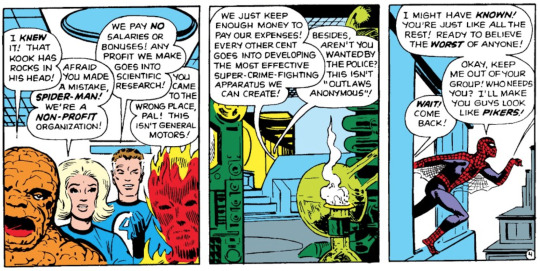
In ASM Annual #3 Peter was far from eager to join the Avengers and was equally unimpressed with them as a group.

He actively sabotaged his own chances to join at the issue’s conclusion.
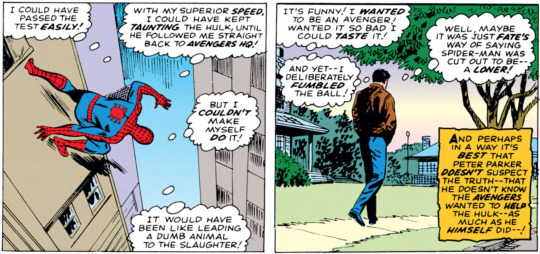
As for Straczynski’s run…sigh…strap in.
At face value this run does indeed seem to support the MCU’s rendition of Spidey. However, the support it offers falls apart due to two factors.
The first is that, well…Peter and Tony’s relationship was pretty nonsensical.
I’m no Iron Man expert so I do not know how old the character would be roughly. From my impressions of the character though circa 2006 he wasn’t even in his 40s yet. Peter by contrast was 30 years old when you do the math. Unlike Tony he’d had several very serious romantic relationships and was back then happily married (barring a brief trial separation). He and his wife had lost a child and even believed one another dead at one point or another. Peter at the time was also working as a teacher to teenagers where he was clearly framed as their elder authority figure.
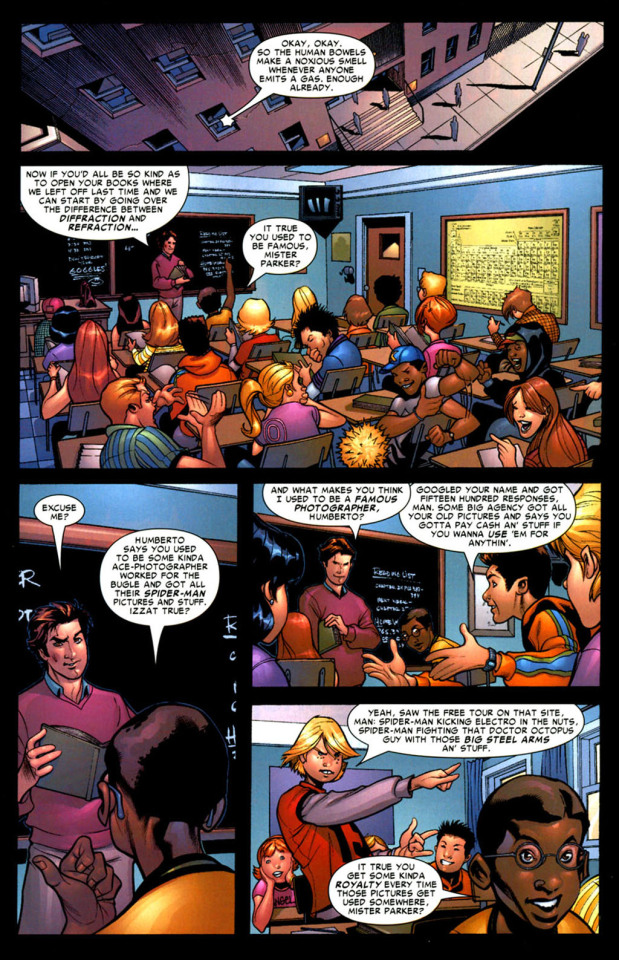
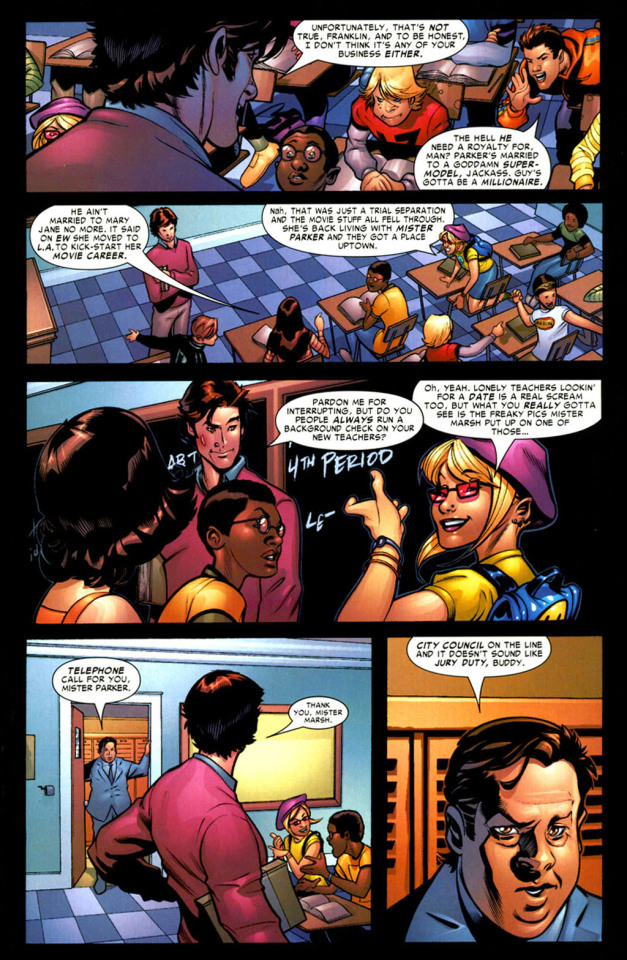
What I’m saying is that Peter was if anything more emotionally mature than Tony at this time. Or at least he was mature to the point where he was not going to view Tony as his father figure given the minor age discrepancy.
The relationship was clearly engineered with the pre-determined endgame in mind. That endgame being the ‘Civil War’ storyline wherein Peter would unmask upon Tony’s request and subsequently become a fugitive in defiance of Tony’s unethical practices. The latter would entail Tony threatening Peter and the pair coming to blows.



This brings me to the second factor. The totality of Peter/Tony’s relationship was designed to be a testament to how it was ultimately a bad thing.
Tony wasn’t the man Peter believed him to be.
Tony didn’t have Peter’s best interests at heart.
Tony was willing to spy, threaten and even attack Peter.
And along the way Peter and his family lost their home and the safety of Peter’s anonymity. The end result was Peter’s life becoming a shell of it’s former self, with his loved ones in serious danger. In fact you could view his fugitive status as a way to recreate the ‘good old days’ when Spider-Man was feared and hated by the public and authorities.
Had Peter retained his independence rather than surrendering any part of it to his ‘father figure’ Tony Stark, much of this could’ve been avoided. If nothing else Peter might’ve been able to unmask privately rather than publicly.
Whilst the MCU addresses the first factor via de-aging Peter, it has no answer for the second. It borrowed from the JMS run superficially and ditched the greater subtext regarding how Peter shouldn’t have formed a relationship with Tony.
I’d like to conclude by addressing the most obvious counterpoint to everything I’ve said.
If Spider-Man were more comic faithful wouldn’t it undermine the entire point of him being in the MCU? The appeal of the concept was seeing Spider-Man interact with the wider MCU. From the audience’s POV seeing yet another Spidey flick confined to using Spider-Man exclusive elements might as well have been produced solely by Sony.
The problem with this argument though is that it doesn’t consider the myriad of possibilities available. Spidey could interact with the wider MCU and still be in character.
I’m no writer but off the top of my head:
Spidey could have defied the Sokovia Accords and thus been wanted by the authorities (a neat updating of his traditional ‘outlaw’ status), consequently coming into conflict with Iron Man
Spidey might have still dueled the Vulture and interacted with Tony as he did in ‘Spider-Man: Homecoming’. However, instead of gradually realizing he should be a ‘friendly neighborhood’ hero, he could call Tony out for ignoring small scale crime which indirectly ‘created’ the Vulture in the first place
Following ‘Avengers: Endgame’ the dissolution of the Avengers combined with the huge uptick in the population and displacement of citizens might’ve caused far more street crime that Peter would have to deal with. The remnants of H.Y.D.R.A. might’ve exploited this to gain a foothold upon which to rebuild.*** That might’ve warrant an appearance from more grounded heroes like Hawkeye or Ant-Man
An environment like this could’ve been exploited by Quentin Beck to frame Spider-Man, exploiting his already shaky public reputation and make himself look more appealing by contrast
Or Hell just do ‘Nothing Can Stop the Juggernaut’ but with the Hulk as Roger Stern planned to do in the first place
I’m sure many of you could suggest infinitely better ideas.
In conclusion, no matter how you slice it, there were better options than rendering Peter Parker Iron Man Junior instead of Spider-Man.
*Peter, as depicted in ‘Captain America: Civil War’ was clearly not well off financially, yet consequent depictions of Peter in the MCU have de-emphasized this to the point where you could argue they are very probably not working class anymore.
This makes sense internally as a billionaire Tony Stark has no reason to take Peter under his wing but allow him to still dumpster dive for equipment. Giving the boy at least some modest financial stability would be a logical step in building a relationship with him and giving him more time and energy to put into his scientific and heroic pursuits.
Whilst I don’t exactly agree with everything said here, this post dives into the subject more deeply.
**And even if it was, if the context demands Peter be rendered so unrecognizable then maybe it was just creatively reductive to integrate him into the MCU the first place.
***They have after all had connections to organized crime in the comics.
#MCU#marvel cinematic universe#Tony Stark#Anthony Stark#Iron Man#Steve Rogers#captain america: civil war#Spider-Man: Far From Home#spider-man: homecoming#Captain America#pokemon#Power Rangers#Teenage Mutant Ninja Turtles#Transformers#Tom Holland#Avengers#The Avengers
129 notes
·
View notes
Text
Fantastic Four Vol 1 #151 & #152
Wed Jul 31 2019 [12:19 AM] Wack'd: Lookin' good!

[12:20 AM] Wack'd: They'll buy some suits and then go out for pizza [12:20 AM] Wack'd: Unfortunately the Baxter Building is under attack [12:20 AM] Wack'd: Bye, suits [12:21 AM] Wack'd: *takes a deep, deep, DEEP breath*

[12:21 AM] Wack'd: this is gonna hurt [12:22 AM] maxwellelvis: Hey, @Bocaj , your buddy's back [12:22 AM] maxwellelvis: He came back in Captain Marvel's most recent series. [12:23 AM] maxwellelvis: The one that put her on Earth to make her more relatable, and then immediately flung her into a Bad Future [12:23 AM] Wack'd: Alright we're doin' this

[12:24 AM] Wack'd: Sure

[12:25 AM] Wack'd: Sick burn by Medusa

[12:25 AM] Wack'd: Also Thundra's shtickiness is wearing off even more now [12:26 AM] Wack'd: Character development is fine but I feel like we didn't get a ton of mileage out of the original concept [12:26 AM] Wack'd: Also: fuck men, for real [12:27 AM] Wack'd: Sue's not a permanent member of the team again just yet, looks like. But I'm glad that, if nothing else, there's some dim recollection that this was all about her being treated with respect

[12:28 AM] Wack'd: Fight fight fight [12:28 AM] Wack'd: Reed, Johnny, and Ben are all down for the count [12:28 AM] Wack'd: This is gonna be a Grrl Power issue, isn't it [12:28 AM] maxwellelvis: yip [12:28 AM] Wack'd: Oh, no, okay. Next one. Cliffhanger.

[12:34 AM] Wack'd: Is it just me or is the credits box getting smaller and smaller every issue [12:34 AM] Wack'd: While Stan Lee's name remains the same size [12:36 AM] Wack'd: So Thundra and...*sigh*...Mahkizmo start to fight but Mahkizmo uses the opportunity to teleport them both to his reality [12:37 AM] Wack'd: Really. Are you really leaving her behind again. Christ.

[12:38 AM] Wack'd: Oh, okay, she's staying behind to man the return switch. At least this is the "we're pretending that you still have something useful to do" variety and not the "you need to stay home with the kid" variety [12:38 AM] Wack'd: Whatever the fuck that's worth [12:39 AM] Wack'd: CLIMATE CHANGE

[12:39 AM] maxwellelvis: Super Kami Guru’s Response To Global Warming [12:40 AM] Wack'd: Gerry Conway says: "It's not abuse unless it's physical!"

[12:40 AM] Wack'd: fight fight fight [12:41 AM] Wack'd: FEMALE EMPOWERMENT

[12:42 AM] Wack'd: FEMALE EMPOWERMENT

[12:43 AM] Wack'd: FEMALE EMPOWERMENT

[12:44 AM] Wack'd: So this is the note that we leave Gerry Conway on

[12:44 AM] Wack'd: It's a cliffhanger [12:45 AM] Wack'd: It's a fitting end for this sickening piece of shit [12:45 AM] Wack'd: This festering bag of garbage disguised as a human being [12:45 AM] Wack'd: Even when he's trying to be feminist he can't even stick the landing and mostly dawdles around showing women being abused [12:46 AM] Wack'd: He definitely has some entertaining stories but they're not good enough to justify the grotesque mass that is his politics [12:48 AM] Wack'd: Oh good! We're entering a tumultuous period that's going to give us work by Len Wein [12:48 AM] Wack'd: Clearly from here things can only get better [12:50 AM] Wack'd: We're gonna stop here. But 1975 is definitely something I'm gonna try and barrel through as quick as possible [12:50 AM] Wack'd: It'll be difficult with four Giant-Size, but I'm determined [03:36 AM] Wack'd: I'll say this, Conway at least seems kinda contrite about the way his *Four* run went [x] [03:37 AM] Wack'd: (He does confirm he didn't really like the Sue divorce stuff and did his best with it which explains a lot) [03:37 AM] Wack'd: (As does the fact that he was younger than I am now) [03:38 AM] maxwellelvis: That explains... a lot. [03:38 AM] maxwellelvis: He was like a KID or something when he started writing comics in the big leagues. [03:38 AM] Wack'd: Yeah he was 22-23. 22 specifically when he killed Gwen Stacy [03:39 AM] maxwellelvis: Suddenly this all makes sense, suddenly I have clarity, insight even. [03:40 AM] maxwellelvis: And this was at the same time he invented Red Sonja, and now everything about THAT makes sense too. [03:40 AM] Wack'd: So I looked up Sonja and it's...less bad than the sort of cultural memory of it? [03:40 AM] Wack'd: Still not great [03:41 AM] Wack'd: She gets raped, and a goddess gives her superpowers that she will lose unless anyone she fucks beats her in combat first, which--*yikes* [03:41 AM] maxwellelvis: I still find Sonja a little less interesting than the actual Robert E. Howard character she's named for [03:41 AM] maxwellelvis: THAT's what I was going for. [03:42 AM] maxwellelvis: "Red" Sonya of Rogatino, who I've mentioned before [03:42 AM] maxwellelvis: As you can see here, the literary Sonya is a very different person from Sonja [03:43 AM] maxwellelvis: I think about the only similarities are both are women with red hair and skill with a blade. [03:44 AM] Wack'd: I'm not, like. Forgiving Conway or anything. He still wrote really shitty stuff, the only difference being that he had a far bigger outlet than most of the shitty 20-somethings of the world [03:44 AM] Wack'd: I just...hope he grew out of it [03:45 AM] maxwellelvis: I'm not forgiving him either, I'm just saying I get it now. [03:45 AM] maxwellelvis: Of COURSE a dumb kid would just re-shift the entire relationship of a character like that, several times. [03:46 AM] maxwellelvis: Of COURSE a guy just out of that last burst of adolescence would invent a warrior woman who only sleeps with those who can beat her. [03:47 AM] Wack'd: Uhh that was Roy Thomas, actually. So like [03:47 AM] Wack'd: Side-eyein' him a bit now too, definitely [03:47 AM] Wack'd: Anyway he went on to create Power Girl and Vixen so like [03:48 AM] Wack'd: This is what happens when you're given everything you wanted at age 22 and it works out great for you [03:48 AM] Wack'd: No incentive to change [03:49 AM] maxwellelvis: Certainly not when you've got a horny old horror comics illustrator drawing for you (Power Girl) [03:50 AM] Wack'd: Dude got to write Superman vs. The Amazing Spider-Man at age 26 [03:50 AM] Wack'd: Like. Why would you do anything differently? [03:50 AM] maxwellelvis: So THAT'S what happened to the man who suddenly got everything he ever wanted. [03:50 AM] Wack'd: He continues to be a shitheel with no repercussions! [03:51 AM] maxwellelvis: Exactly, he lived happily ever after [03:51 AM] Wack'd: Christ [03:51 AM] maxwellelvis: I had to say it. [03:51 AM] Wack'd: I'll just say I'm very happy no one ever saw the shit I did as a teenager/college student [03:51 AM] Wack'd: And leave it at that [03:52 AM] maxwellelvis: I know I produced a lot of stuff I don't want the world seeing.
2 notes
·
View notes
Text
In Spider-Man the Animated Series Season 1 episode 5 ‘The Menace of Mysterio’, Mary Jane asked Peter to help her study for a physics exam she had coming up due to struggling. However she eventually studied herself (and passed) finding the task easy following a certain revelation she had. To quote her from the episode:
Physics is a lot like theater. It’s all about making sense out of life.
Not only was this moment really nice in the 1994 cartoon series BUT...it actually illustrates a perhaps unintentional aspect of Peter and MJ’s relationship.
So often we hear that Gwen Stacy, or Carlie Cooper or any other hypothetical girlfriend for Peter would be a better fit than Mary Jane due to their mutual interest in his passion for science, something MJ lacks.
Putting aside how MJ has never expressed outright disdain or disinterest in science (Peter has explained scientific theories to her) and studied a branch of it herself (psychology which IS a bona fide scientific field) MJ’s own passion for acting (i.e. becoming someone else in service of a story) does connect to Peter’s love of science on some level.
Science exists to investigate and (in theory) improve upon the world around us and our own lives for specifically.
Whilst storytelling might not always seek to improve lives in the same way, they do exist to entertain and thus potentially improve, however briefly, audiences who consume them. And the best kinds of stories can strike a chord in audiences and stick with them potentially entertaining, educating and even shaping people to some extent throughout their lives.
But first and foremost storytelling did evolve as a way to make sense out of life by taking aspects of it and presenting a digestible, understandable and repeatable way.
In fact one could argue the earliest forms of storytelling are cave paintings, which are on the most deeply humanistic level an attempt for our ancestors to try and understand themselves and the world around them. To make sense of life. I suppose in a way you could argue those caveman paintings were also an early example of science in action too, giving both a common root.
After all a key tenant of science and storytelling is observation.
Observation is critical in the scientific method and experiments, and in storytelling (consciously or not) the narratives storytellers forge are informed by what they have observed in their lives, with their works on some level attempting to make sense of those things or help others to do so.
So, whilst they differ greatly, Peter’s passion for science (via his study of bio-chem, or whatever his major was they change their mind a lot about it) and MJ’s passion for storytelling (via acting) actually DO complement one another even though they are very different.
Much in the same way that Peter and MJ both understand what it is like to live a double life, to lose a parent, to work to support your family at a young age, to come from a home shattered by tragic circumstances, to on some level be an outsider, to employ humour and a performance of a sort as a coping mechanism and to cope with guilt over neglecting your responsibilities and hurting your family as a result. Even though in all cases their experiences are not a 1:1 comparison.
They are different, yet on their deepest most fundamental levels the same.
P.S. Not for nothing but the Spider-Man film regarded as the high water mark of Spidey on the Silver Screen presented a scientifically minded man in a clearly very loving and endearing marriage to a woman who was more interested in the arts such as poetry.
youtube
P.P.S. I know a man who’s field of study and work focuses upon mathematics, physics, finance and engineering.
I know a woman who’s field of study and work focuses upon psychology, English language, English literature, nutrition and biology.
They’ve been married since 1984 when they were around 25 years old.
#Spider-Man#mjwatsonedit#mary jane watson#Mary Jane Watson Parker#MJ Watson#peter parker#spider-man the animated series#Spider-Man TAS#Spider-Man 1994#Spider-Man 1994 cartoon#Spider-Man 2#Doc Ock#otto octavius#Doctor Octopus#Gwen Stacy#carlie cooper
64 notes
·
View notes
Photo

Marvel Rising: Initiation Review
spoilers spoilers spoilers spoilers spoilers spoilers spoilers spoilers spoilers
Disney XD premiered the first installment of the Marvel Rising Secret Warriors animated series with past Monday with the very enjoyable Initiation; directed by Alfred Gimeno with a screenplay by Mairghread Scott and the vatic talents of Dove Cameron, Chloe Bennet, Tyler Posey, Kathreen Khavari, Milana Vayntrub, Cierra Ramirez and Kamil McFadden. Quick recap and review following the jump.
The Mysterious Ghost Spider is on the run with the authorities believing her responsible for the death of a young man named Kevin. After handily defeating a battalion of the city’s best police officers, Captain Stacy chooses to request assistance from Shield. Agent Daisy Johnson and Patriot are assigned to the case and pledge not to rest until this hero-turned-villain can be brought to justice. Patriot is a newer hero who has been trained by Captain America himself and is quite eager to prove himself. Daisy, meanwhile, is more seasoned and right from the start she suspects there might be more to this case than simply a former hero gone bad.

It’s rather clear from the onset that Ghost Spider is not a villain, rather it is an unfortunate set of circumstances that has made it appear as though she was responsible for Kevin’s death. Nothing could be further from the truth. Ghost Spider is actually high schooler, Gwen Stacy, and Kevin had been her best friend.

Following an oddly shoe-horned in scene where Gwen practices with her and her friends’ garage band, Ghost Spider returns to the streets in search of the real culprit behind Kevin’s death. She encounters Patriot, and following a brief skirmish, Ghost Spider is able to escape.
Elsewhere, Doreen Green arrives on her scooter with a box of cupcakes meant to commemorate the triumphant first team-up between her, The Unbeatable Squirrel Girl, and her new best pal, Kamala ‘Ms. Marvel’ Khan. Doreen’s squirrel buddy, Tippy Toe, is also on-hand and doesn’t want to wait for Kamala to arrive before getting into one of those delicious cupcakes.

Kamala arrives and the focus of their first mission together presents itself when they see Ghost Spider and set out to bring her to justice. An elaborate and rather silly battle unfolds as Ms. Marvel, Squirrel Girl and Tippy Toe match up against Ghost Spider.

Ghost Spider is eventually captured and pleads to be let go, demanding that she is innocent. Ms. Marvel and Squirrel Girl agree to hear her out. Ghost Spider explains that she would never hurt Kevin, he had been her best friend. He was also an Inhuman who was transformed by way of the Terrigen Cloud. Terrigenesis endowed Kevin with ice powers and Ghost Spider helped him hone these newfound abilities so that they might be crimefighters together.
Yet on the night of their first outing, Ghost Spider arrived to find that Kevin had been murdered. The apparent culprit was a super powered woman with yellow skin and green hair who wielded energy knives. Even the slightest cut from these knives had the effect of effectively draining one’s life energy.

Ms. Marvel and Squirrel Girl believe Ghost Spider’s story and chose to let her go, agreeing to also seek out this mysterious villain who is actually behind Kevin’s death. Shortly thereafter, Ghost Spider is once more engaged by The Patriot. This time, however, Patriot utilizes teamwork and lures Ghost Spider into a position where Agent Johnson can sneak up behind her and neutralize her with her quake powers.

Ghost Spider is apprehended by the two agents and taken by car to police headquarters where she is to be handed over to Captain Stacy. Again Ghost Spider proclaims her innocence, telling the story of the mysterious villainess with the life-draining energy knives. Daisy is intrigued by the tale… she has heard about evil Inhumans with similar powers and Kevin’s death may have something to do with an ongoing case she has been investigating. Furthermore, upon reading Ghost Spider’s reaction to seeing Captain Stacy, Daisy correctly surmises that Ghost Spider is actually Captain Stacy’s daughter, Gwen.
Daisy furtively arranges for Ghost Spider to escape just as she is delivered to police headquarters. Captain Stacy is incensed and demands that Shield stop at nothing to bring her in.

Some time thereafter, Ghost Spider seeks out Daisy and asks her why she allowed her to escape. Daisy explains her suspicions that Kevin’s death may be part of a bigger threat posed by an evil Inhuman, and that she may actually need Ghost Spider’s aide in taking down this threat. Daisy tells Ghost Spider to continue her investigation and to keep her apprised of things, especially if it entails an Inhuman with teleportation-based powers. Ghost Spider agrees and they part company. And it is hear that the episode comes to an end with it looking quite likely that the mystery will once again bring these various heroes together in future installments.
This was a quick, fun and very enjoyable affair. It moves quite fast but its speed doesn’t come at the cost of the plot. It sort of drops the viewer right into the heart of the action and has faith that said viewers will be able to piece things together on their own as further details of the plot are divvied out. I quite like this approach, especially in lieu of other animated shows aimed toward younger audiences that sort of treat the viewer as simpletons who need the plot clearly laid out.

This first episode is very much a Ghost Spider story and Gwen makes for a highly likable protagonist. Voice actress, Dove Cameron, does a terrific job bringing Gwen to life, with snarky commentary, good comic timing, as well as a distinctive undertone of sadness (sadness based on the death of her best friend, Kevin). Fans of the Spider-Gwen comic series are likely to very much enjoy this animated version of the character; it’s quite faithful to her personality in the comics.
The story takes a few more liberties with the Squirrel Girl and Ms. Marvel. Squirrel Girl acts as the comic relief, bubbling with enthusiasm and goofy energy. She’s a good deal less thoughtful than her comic book counterpart. The comic book version of Squirrel Girl always seeks out a nonviolent solution to problems before resorting to fisticuffs, yet this animated version is quite eager to battle Ghost Spider.
Milana Vayntrub clearly has a lot of fun voicing Squirrel Girl and isn’t at all shy about hamming it up. There is a particularly funny bit where Squirrel Girl decides that their battle-moves would be more effective were they to call them out the way they do in popular anime, like Dragonball or Naruto.

I also like that Squirrel Girl is illustrated as more full-figured… although it sort of bugs me that the bigger girl ends up being the goofier, comic relief (it’s a tired trope).
Squirrel Girl’s jokes and shenanigans sort of overshadow Ms. Marvel and she doesn’t get much of a focus in the episode. Kathreen Khavari voices Kamala, reprising the role from Ms. M’s appearances in Avengers Assemble. I’m definitely looking forwards to seeing Ms. Marvel get more screen time as the series progresses.

Kamil McFadden voices Patriot and, next to Ghost Spider, is the character who gets the most spotlight. Patriot takes himself quite seriously. He’s ready to prove himself and is quite proud of the fact that he had been trained by Captain America. At the same time, however, there is also an edge of insecurity to Patriot, possibly a worry that he might not live up to his potential. It’s an edge that makes him a more compelling character as opposed to someone whose cockiness might cause one to root against him. There is also a touch of flirtation in his and Ghost Spider’s banter… I wonder if this is a hint toward a possible romance between the two later down the line.

Chloe Bennet is very much at ease in the role of Daisy. She plays her as shrewd and cunning. She’s a much more experienced agent compared to her partner, Patriot, and ready to take calculated risks to get to the bottom of things. It’s a neat take on Daisy and a bit of a departure from the more leap-first-look-later version of her we last saw in the pages of Matt Rosenberg’s Secret Warriors run. Like Ms. Marvel, I’m looking forward to seeing what the next installments have in store for Daisy.
The villain who killed Kevin looks a good deal like the Inhuman baddie called Sheath, although it is possible that she is actually a brand new character. And it seems likely that the big bad of the arc will end up being the dark force wielding cad known as The Exile.

The animation is fair. It’s a step above more recent Marvel animated projects, like Avengers Assembled and Hulk Agents of Smash, but not as stellar as similar outings from DC (such as Young Justice or Batman: The Animated Series). It’s good, but not great. The backgrounds are rather static and nothing to write home about, but the action is fluid and dynamic. Squirrel Girl’s accentuated facial expressions showcase the best part of the animation.

All in all, Marvel Rising Initiation is absolutely worth checking out. It’s a fun detour into the world of the lessor well known Marvel heroes, with a refreshingly diverse cast of characters and an intriguing plot. Definitely recommended. Four out of five Lockjaws

53 notes
·
View notes
Text
Elsewhere University - Feathers, Part 5
part: one two three four, or On AO3
Hello my dears!! I regret that I haven't been able to update as quickly as I was for the first few chapters, but that's what suddlenly!more hours at work, plus a research class shifting into high-gear (holy shit guys I'm presenting in the poster session at the WPA at the end of this week. guys. guys i'm a scientist ), plus getting ready to graduate, plus an LSAT prep class will do. -_-
But!!! better late than never, so here we are!! As always, I hope you enjoy. :D
Oh- the motto is cannon for @elsewhereuniversity from @charminglyantiquated, who is, as always, ever so generous to let us all play in her sandbox
Previously: ‘It was an interesting read?’ you offer, feebly. He snorts, and the humanity of it makes your skin crawl.
‘This will be moreso.’ he says, and he is gone, wind tearing at your hair and clothes, knocking over cups and stealing napkins.
The Crow Prince is gone, and in his place is a book.Over an illustration of a laughing crow, So You Want To Go To Underhill is written in starlight on the cover.
Part 5
Hair ruffled and wind blown, clothes tugged askew, the four of you stare down at the book. Thirteen clears his throat.
‘Yeeeeah, one of you can carry that. I'm new to all this shit, but I'm still pretty damn sure I don't want to touch that.’ He pops a stray grape in his mouth, as if to emphasize his point.
Cat-Eyes laughs, a little hysterical.
‘We just had a picnic lunch with the Crow Prince, Feathers. With the Crow Prince.’
Next to her, Not-Jenna stretches out a hand to lift up the cover a scarce half inch. What ever she sees is enough to make her snatch her hand back with a squeak and let the cover fall shut.
‘Feathers, that book is definitely for you specifically,’ she says, and you have to sigh. Of course it is.
You waffle for a moment- it would be smarter to take the book back to your dorm. Definitely smarter.
(but you're getting sick of running scared to your dorm after every excursion. ..and anyway: if you were smart, you'd have never come back here, armed to the teeth with pearls and salt and the scent of flowers)
You reach out, snag the book, drag it into your lap. You hover a hand over the cover, wait for someone to object.
No one does.
You flip the book open, and... nothing happens.
(You're.. a little disappointed, to be honest.)
Just as you let your hand fall away from the book, you're started by a course, hacking caw.
‘Leaving without me!!’ Barnes croaks, and if the Crow Prince hadn't knocked everything askew with his leaving, Barnes would have with its arrival.
You lean back as Barns ruffles its wings.
‘Bad Feathers!!’ It caws again, accusing.
You look at you companions, and they stare back, as bemused as you are.
‘Ah, you want to come with us?’ you ask Barnes.
‘Crow Girl without a Crow,’ It tells you, hopping closer to you and turning its head to peer at you, tone scolding, 'not quite a Crow Girl.’
‘Well.’ You say. Not-Jenna shrugs, Cat-Eyes is still making faces and mouthing 'Crow Prince!', and Thirteen is still too hung up on the talking crow thing to be of any help.
Barnes clacks its beak at you, clearly annoyed. You shrug at the others, and tell it, ‘Well, if you want to come with us I'm certainly not going to tell you ‘no’, now am I?’
Barnes horks out some noise you're pretty sure is supposed to be an exclamation of joy, and the book on your lap flashes. The wind picks up, the pages start flapping, and the whole world turns bright, so bright, (starbright), so bright it hurts your ears, and your eyes burn even as you cover them.
Barnes’ Hrah! Hrah! Hrah!s and the rustle of wings follow you down into unconsciousness.
---
When you surface from your forced vacation from the waking world, your head feels as though it’s had the insides of a blender installed and then turned on until your poor, poor brain is a smooth gelatinous liquid. You reach up a hand and are vaguely surprised you can’t feel it dripping out your nose.
In other news, your mouth tastes like death.
You groan, and roll over so you're on your back, instead of curled up in the fetal position. You spend a long moment psyching yourself up, and then open your eyes.
Above you (once your eyes stop feeling like they're about to pop from the light), you can see golden motes of dust hanging suspended in the air, drifting lazily, illuminated by the shafts of sunlight that sneak through the wooden slats of the roof. It smells like horses. One hand is still on your head, but you scrabble the fingers of the other on the floor, and yeah, you're lying on dirt.
Distantly, you're aware of the sound of large things breathing quietly, the soft thwip of tails being whipped through the air, the groaning creak of a wooden door complaining at being leaned upon.
You're pretty sure you're in a barn.
(the air tastes strangely, the sunlight- what creeps through the roof, anyway- is heavy. The dirt you scrape your fingers through feels...less gritty? maybe?? than you think it should, as though it were born from the idea of dirt, more than the slow death of ground stone and decomposing organics.)
(You're pretty sure you're in an Underhill barn.)
A throat clears.
It's a girl. Or, rather, a woman, if only just. She's sun-worn, well muscled, wearing a liberal coating of dust and horse-hair over jeans and a shirt with its sleeves rolled up, a sword- incongruously ornate, both the sheath and the hilt- on her hip, and leaning on a pitchfork as she waits for you to notice her.
She feels solid, feels human, and though you'd think she'd feel out of place she really, really doesn't.
(You think maybe this place is hers, the way Dorm 5 now belongs to you.)
You stare at each other, you still flat on your back, the woman still leaning on her pitchfork, until your next inhale drags just a little too much dust in through your nose and you jackknife up with the force of your sneeze.
Several horses snort and shift at the sudden noise, and the woman snorts at you as well, though she's distinctly amused, not startled.
‘You wanna tell me what the hell you’re doing in my barn?’ She asks, and manages to imply a total ambivalence as to whether she'll get an answer or end up burying her pitchfork in your squishy, squishy innards in the doing of it, if only because you're not worth getting her blade dirty.
(you're a little impressed, behind the sudden mortal terror. She didn't even change her body language, and that still came across crystal clear. This woman is perfectly relaxed, and absolutely ready to kill you for invading her space.)
‘Ah,’ you stall, and then settle on, ‘We mean no offense, and we certainly don't mean to trespass. I don't quite know why we're in your barn, but, well... I'm pretty sure we're on a Quest.’
Her eyes, flinty already, narrow.
‘We?’
And that's when you realize the others aren't with you. You shoot to you feet, and the woman shifts her weight back.
‘Where are they!?’ You demand, and there's something dark and possessive rousing itself in your breast.
(if she's taken them, if she's hurt them, you’ll.. you’ll... you'll scream and you'll bleed and you'll call for the Crow Prince and you'll make yourself a deal, is what you'll do.)
‘Where're who?’ Her easy drawl has an edge to it, her hands tighten on her pitchfork.
‘My-..’ you falter, rein yourself in, take a breath.
(You don't know that she's done anything, you're in her space, now is not the time to start a fight. Deep breaths.)
‘My companions. A boy who goes by Thirteen, a girl called Cat-Eyes, a changeling called Not-Jenna. And a crow who answers when I call him Barnes.’
‘Yours, huh?’ She says, and you know what she's asking.
‘Yes, mine.’ You'll apologize to Barnes later, but if he didn't want you claiming him he shouldn't have gone on about how a Crow Girl can't be without a crow.
(...You're not apologizing to the Thirteen or Cat-Eyes, though. They've been living in your space and following your lead. They can deal with it.)
She sighs, some of the ready-tension leeching out of her.
‘I have no idea where your companions are, and even if I did, you’d still need to leave. Her Ladyship’ll be by for her afternoon ride pretty soon, and she is much less likely to tolerate someone from the Autumn Court on her lands than I am, Quest and no.’
That throws you.
‘Uh, I'm not from the Autumn Court. Not from any Court.’
She looks squints at you.
‘You sure?’
‘Very. I’m a Psych major from Elsewhere.’
She lights up, and begins to chant, ‘Cauti, Cordati - ‘
‘Auspicati!' You finish with her. (Elsewhere University’s sometimes motto: Wary, wise, and fortune-favored.)
(As with most things Elsewhere, this is more true for some than for others)
‘You're from EU! That changes things. You still need to leave- from a Court or not, you're sure as hell affiliated, don't even try to tell me otherwise- but I can help.’
That pulls you up short, and she notices.
‘I won't ask for payment now,’ she tells you. ‘You'll owe me a favor, but nothing big. I'm gonna help you on your way, avoid meeting the Lady of the Summer Court who rules here, so maybe someday, when I'm ready to move on, you introduce me to someone in whichever Court you're involved with, yeah? Nice and symmetrical.’
You... can agree to that. You bop your head once in agreement, then offer your hand to seal the deal.
She takes your hand, grip firm, and the two of you pump your joined hands in tandem; once, twice, and thrice to seal the deal.
‘I'm called Crow Girl,’ you tell her, and she laughs.
‘Guess we're both named for what we're affiliated with, yeah? I'm called Appaloosa. Now, Crow Girl, come with me.’
You go with her.
--
Appaloosa hides you in the back of a tack room- one of many, apparently, and currently just used for storage, Appaloosa tells you.
(Appaloosa tells you many things. For instance, she wasn't stolen, she has a contract with the Lady who owns these lands, drawn up by Stacy in Law. You've never heard of Stacy in Law. You've never heard of employment contracts with the fae, either.
When you tell her this, she looks at you funny, tells you she was one of the ‘eck girls.’ At your blank look, she continues, ‘The eck team? E-Q, short for equestrian?’
When you tell her that there isn't an equestrian team at EU, she snorts, tells you, ‘Maybe not at your EU.’)
(Elsewhere is an intersection more than anything else- the fae love it just as much because it gives them a foothold in the human world as they do for how it slides between whens, wheres, and whiches.)
(The fae aren't the only ones who love Elsewhere for its transitory nature, but you've never had the luck- good or bad- to run into any of them.)
(You think.) (...Jimothy probably counts, now that you think about it.)
She has duties to attend to for the rest of the day and much of the evening, so you spend the hours reading Scyt’s book, and then when your eyes refuse to parse the letters anymore (as much from the dimming light as from the strangeness of them), you try to dose.
It's warm, in the tack room, and you’ve re-purposed a stack of saddle pads three feet high as a place to rest. Leaned up against the wooden walls, curled up with a book and the scent of summer think in your lungs, it's easy to drift off, even with your worry for the others taking up space in your stomach.
(Several times you...’wake’ isn't quite the right word. Several times, you drift closer to consciousness, and then drift back down into the grasp of sleep, as easy as the tide.)
(you dream that you made friend of a thing of the Summer Court instead of the crows, took up the sword instead of the pen, studied medieval literature instead of the modern mind. When you slipped, when you fell, when you faltered, they took you away from Elsewhere, where the Summer Court stands subservient to the Spring, and they called you the Red Handed for the things they had you slay)
(you dream of biting into summer-ripe fruit - peaches, cherries, strawberries, a different fruit each time you fall, the taste like rust in your mouth, red juices and pulp dripping down your chin, your hands, onto your chest and wrists until you are all-over stained with it, until all you touch is stained with it.)
You wake (and the dream fades, though not the tang of blood, heavy upon your tongue, nor the feel of a blade, heavy in your hand, and you wonder at the sensations, not knowing where they came from) to Appaloosa calling for you in hushed whispers, the the shelves and tack around you turned unfamiliar and sinister with the lack of light.
You straighten up from where you've slumped against the wall, wipe the cobwebs away from where they've stretched across your eyelids, put your book back in your bag, walk with careful step to where Appaloosa waits for you.
When you get close enough to make out her expression, you see that it's grim. Her sword is loose in its sheath.
‘I know where your companions are.’ She tells you.
She's not happy about it.
44 notes
·
View notes
Text
The wasted potential of Clone Conspiracy
Oh son, I ain’t even done b****ing about Clone Clusterfuck yet.
Because what’s arguably the most unforgivable thing about it is the utter waste of potential.
Yeah, yeah obviously Ben Reilly’s return got fucked up, but I’m talking about more than that.
Look, love them or hate them, the big Clone arcs of Spider-Man’s life have at least invited an examination of something poignant to the human experience through the character of Peter Parker. And in fact on balance have provided some pretty deep exploration of the character and even developed him in some pretty siginifcant ways.
The 1970s Clone Saga (which I call Clone Genesis to distinguish it from the 90s storyline) dwelled upon the idea of grief. Gwen Stacy returned in the storyline forcing Peter to address his old feelings for her and his new feelings for Mary Jane. Though he obviously still hurt over her death the story concluded with Peter completing the grieving process and moving on with his life to be with Mary Jane and over all putting Gwen behind him. In this sense Gwen’s clone was a literalised metaphor for her place in his life, her memory, his feelings for her and the guilt he felt in starting to move on from her as opposed to dwelling on her memory and absence from his life. It was particularly poignant as it was in direct contrast with the role of Miles Warren. He also loved Gwen but he didn’t grieve her properly and move on and that pain evolved into an unhealthy obsession to bring her back and avenge her death. To this end he became a monster, committing crimes and breaking the laws of nature itself.
The 1990s Clone Saga was an examination of identity. It had Peter, Ben and Kaine literally and subtextually ask the question of “Who am I?”. They asked it to themselves and to the readers. It was a profound exploration of nature vs nurture. The conclusion of the story illustrated an important point, that being that the circumstances of our births do not determine the value of who we are. Ben Reilly died a hero protecting the man he believed was a pretender to his identity. And yet he was in truth the clone the whole time. Peter Parker was not a clone but the weight of his pain and traumas managed to break him more than once, with Ben being a vital lifeline to bringing back from the edge. Kaine too was someone who was even worse and turned into a monster due to his torturous life, although even then he still drew a line in the sand about how far his actions would go, he after all never murdered for fun or people who were not themselves criminals guilty of serious crimes.
One might argue Peter’s character was developed by proxy through examining Ben and Kaine, but even if you disagree Peter himself did develop as a person, growing to accept that the life he knew wasn’t real but that it did not matter, thus teaching him an important life lesson about how our actions are what’s important. He also developed as someone who now had a brother to bond and confide in, as a husband who chose to retire for his wife’s sake and as an expectant father. We knew a Hell of a lot more about Peter Parker at the end of the 1990s Clone Saga than we did at the start and he was a much more layered character when all was said and done.
But then we have Clone Conspiracy. All of the people barring one whom Peter had seen die on his watch, all the people he arguably felt guilty over were seemingly alive and well again. And...we got very little emotional reaction from him. Peter felt immense anger and hurt at the sight of Gwen or when he first met Ben Reilly. Here though? Slott utterly undersold the realistic emotional impact this story would have upon Peter Parker, as evidenced by the offhand comedic way it was referenced in ASM v4 #25 and the lipservice he paid to the ‘therepy’ everyone would need in the wake of the story.
Nowhere could it be more evident that Dan Slott is a writer unsuited for Spider-Man. Spider-Man is all about introspection and emotions. The ‘Big Concepts’ that might work well for a science fiction series like Doctor Who or Silver Surfer at worst have no place in Spider-man and at best are entirely secondary to how they affect the characters on an emotional/psychological level.
In this case it’s less important to examine the societal question or shock value of using cloning to revive the dead than it is to ask “How does Spider-Man feel about this”. You HAVE to get into his head you have to show the gauntlet of emotions he’d be running through. And there is incredibly fertile ground to do that with this story but it’s just amounts to continuity porn. We get maybe a few lines of dialogue exchanged between Spider-Man and his dead loved ones sans Gwen and that was it.
It’s like in Spider-Verse, where you could do so much from Peter meeting the daughter he never had, or meeting Ben Reilly again, or of Mayday meeting Ben Reilly, or Hell of Peter getting to have a heart to heart with a version of Gwen. But it’s not there. It’s just focussed upon the fact that all these people are in one big story and that there is a grandiose threat at hand.
In this story why on Earth did Peter not have a conversation with Jean DeWolff where they FINALLY got to talk about how she was in love with him? Why couldn’t Peter tell Ned how sorry he was about letting him die or about Hobgoblin setting him up? Why the fuck didn’t he have a sit down with George Stacy and ask how and when he learned Peter’s identity or apologise for not living up to his promise to protect Gwen?
I’ve already talked about how godaweful that conversation issue with Gwen was but even then Peter didn’t seem that affected in or after the story over the facts that
a) Gwen died whilst conscious and feeling betrayed by him and
b) She essentially forgave him for her death
One or both of those things should have a profound impact upon Peter going forward. He should feel even more horrible about letting Gwen die and possibly re-examine the idea of him dating in light of that. or he should feel immense relief since he’s been atoned for the sin of accidentally killing her.
But he doesn’t. He has a few reaction shots and then its back to normal.
The story basically serves to bum Peter out like countless stories beforehand have. Not only is that reaction immensely cheap and undermining to the realities of how he would feel but again every major clone storyline before Clone Conspiracy (which is a sequel to the 70s and 90s storylines) has served to do some poignant point of character exploration for Peter and develop him going forward. And this one just didn’t do that at all.
And again it COULD have.
On a broad thematic level Clone Conspiracy could’ve examined the theme of grief and guilt in Peter’s life like the 1970s storyline but in a new and different way. Or it could have served to reaffirm or more clearly define Peter’s attitude to death and ethics regarding it. It could’ve been the story which illustrates how and why Peter carries those he’s lost with him but doesn’t let their deaths eat him up inside.
Or it could’ve developed him by having those he’d lost learn who he was, why he does what he does and better understand him. And from that they could either have forgiven him for their deaths or made it clear they didn’t blame him in the first place.
In a sense this would clear the slate for Peter’s conscience allowing him to go forward in his life unburdened by any lingering guilt he might have felt over losing those people and/or not blaming himself for any future deaths that might occur believing that those he let die would have forgiven him or not blamed him if they truly understood him. It could allowed Peter to accept he is ultimately human and that so long as he does his best he has nothing to feel guilty about.
Now do I think that’d be a good IDEA to go that route? Well maybe, maybe not.
But it would’ve been SOMETHING beyond the loud frivolousness of the story as we got it.
#Clone Clusterfuck#Clone Conspiracy#clone saga#Gwen Stacy#George Stacy#captain george stacy#peter parker#ben reilly#kaine#kaine parker#scarlet spider#the jackal#jackal#miles warren#mary jane watson#Mary Jane Watson Parker#Dan Slott#Jean Dewolff#Ned Leeds#Hobgoblin
23 notes
·
View notes
Text
JWT’s Future 100 Tells Us Tomorrow Is All About Health
From culture to travel, food and drink to retail and beauty, health will be baked into consumer goods and experiences in 2019.
Welcome to The Future 100: 2019 from The Innovation Group at JWT. In the 100 emerging trends across ten categories, the future is clearly health-driven, according to the tea-leaf readers at JWT.a
Health is all over,
Culture
Tech and innovation
Travel and hospitality
Brands and marketing
Food and drink
Beauty
Retail
Luxury
Health (as a category itself)
Lifestyle.
I’ve mined this report in previous years – you can review my findings from the 2017 report here in the Health Populi post, Health is Everywhere in 2016.
Among the ten trend-examples in the Health section, I pulled out Healing Cafés here. This speaks to an increased awareness of mental health, recognizing the mass experience/prevalence, the under-supply of professional therapists, and the opportunity to leverage the available supply of public spaces for “recharging and rebalancing in hectic cities,” JWT observes. I’ve experienced an example of this in London at the Frazzled Café which is sponsored by Marks & Spencer, the retailer, and inspired and founded by Ruby Wax. Ruby is a British performer, writer, and all-around lovely human. The Frazzled Café convenes bi-weekly meet-ups in Marks & Spencer Cafés for people throughout the UK, conceived as places where “it’s OK to no be OK.”
In the U.S., HealHaus in Brooklyn offers such a respite. “At HealHaus, we question how we work through the harder topics, not just the easy ones,” the studio’s founder told JWT.
The concept of Healing Cafés is most popular in Asia, where living in very crowded cities is a norm for many people.
Health Homekits Upgraded is another Health trend to note in the JWT report. This addresses the growing DIY healthcare/self-care concept powered by personalized medicine and technology that helps to scale it. As an example of the trend, JWT talks about tech-enabled fertility programs in the hands of consumers. People order tests online, complete their “homework,” and return samples back to labs. After data are crunched through AI systems and reviewed by medical professionals, the companies develop personalized treatment plans and recommendations. The write-up mentions Thorne Research and Modern Fertility, along with Biem further expanding the market for sexual health testing. “We want to empower people, make them proud of getting tested, and make that become the norm,” Beam founder Bryan Stacy explained to JWT.
JWT also recognizes consumers’ growing embrace of food-as-medicine in the trend Nutritional Snapping. “These apps illustrate the potential for tech to simplify consumers’ paths to optimal well-being,” JWT summarizes. The barrier to food tracking has been lack of simple ways to do it. Increasingly, photographing food and scanning labels is getting easier and more effective to do. JWT features the Pinto app: this tool is built on about 100,000 food products that represent 85% of the top-sellers in the U.S. The platform enables users to identify their preferred eating style (or “food tribe”) — say vegan, paleo, diabetic — and scan products’ nutrition labels to generate a personalized version based on eating style and preferences. For example, a person managing heart disease can identify whether a particular product is high in fat or salt.
The remaining seven Health trends are:
Empowering adolescence
Rebooting men’s wellness
Circadian rhythms
Community spas
Silence
Asia wellbeing wave
China health tech.
And you’ll find even more health-related trends blurred throughout the report, such as energy-positive hospitality (part of medical tourism), fitness interfaces, vegan luxury, diagnostic travel, and elemental health experiences, among others. Review the report and you’ll be sure to have some lightbulb moments through your own work and life lenses.
Health Populi’s Hot Points: In the Tech & Innovation list of ten trends, you’ll find Humanizing Tech. JWT describes this trend as tech brands, “trying to blend in, carving out space in our homes and on our bodies to integrate into everyday life.”
Ultimately, nearly every trend on the JWT Future 100 has a technology-underpinning. Tech can scale services, knowledge, and empowerment, especially for health — the most humanizing sector of all industries (or should be, anyway).
Kudos and thanks to the JWT Innovation Group for giving me another great year of thinker-toys to inspire my own work and world.
The post JWT’s Future 100 Tells Us Tomorrow Is All About Health appeared first on HealthPopuli.com.
JWT’s Future 100 Tells Us Tomorrow Is All About Health posted first on https://carilloncitydental.blogspot.com
0 notes
Text
JWT’s Future 100 Tells Us Tomorrow Is All About Health
From culture to travel, food and drink to retail and beauty, health will be baked into consumer goods and experiences in 2019.
Welcome to The Future 100: 2019 from The Innovation Group at JWT. In the 100 emerging trends across ten categories, the future is clearly health-driven, according to the tea-leaf readers at JWT.a
Health is all over,
Culture
Tech and innovation
Travel and hospitality
Brands and marketing
Food and drink
Beauty
Retail
Luxury
Health (as a category itself)
Lifestyle.
I’ve mined this report in previous years – you can review my findings from the 2017 report here in the Health Populi post, Health is Everywhere in 2016.
Among the ten trend-examples in the Health section, I pulled out Healing Cafés here. This speaks to an increased awareness of mental health, recognizing the mass experience/prevalence, the under-supply of professional therapists, and the opportunity to leverage the available supply of public spaces for “recharging and rebalancing in hectic cities,” JWT observes. I’ve experienced an example of this in London at the Frazzled Café which is sponsored by Marks & Spencer, the retailer, and inspired and founded by Ruby Wax. Ruby is a British performer, writer, and all-around lovely human. The Frazzled Café convenes bi-weekly meet-ups in Marks & Spencer Cafés for people throughout the UK, conceived as places where “it’s OK to no be OK.”
In the U.S., HealHaus in Brooklyn offers such a respite. “At HealHaus, we question how we work through the harder topics, not just the easy ones,” the studio’s founder told JWT.
The concept of Healing Cafés is most popular in Asia, where living in very crowded cities is a norm for many people.
Health Homekits Upgraded is another Health trend to note in the JWT report. This addresses the growing DIY healthcare/self-care concept powered by personalized medicine and technology that helps to scale it. As an example of the trend, JWT talks about tech-enabled fertility programs in the hands of consumers. People order tests online, complete their “homework,” and return samples back to labs. After data are crunched through AI systems and reviewed by medical professionals, the companies develop personalized treatment plans and recommendations. The write-up mentions Thorne Research and Modern Fertility, along with Biem further expanding the market for sexual health testing. “We want to empower people, make them proud of getting tested, and make that become the norm,” Beam founder Bryan Stacy explained to JWT.
JWT also recognizes consumers’ growing embrace of food-as-medicine in the trend Nutritional Snapping. “These apps illustrate the potential for tech to simplify consumers’ paths to optimal well-being,” JWT summarizes. The barrier to food tracking has been lack of simple ways to do it. Increasingly, photographing food and scanning labels is getting easier and more effective to do. JWT features the Pinto app: this tool is built on about 100,000 food products that represent 85% of the top-sellers in the U.S. The platform enables users to identify their preferred eating style (or “food tribe”) — say vegan, paleo, diabetic — and scan products’ nutrition labels to generate a personalized version based on eating style and preferences. For example, a person managing heart disease can identify whether a particular product is high in fat or salt.
The remaining seven Health trends are:
Empowering adolescence
Rebooting men’s wellness
Circadian rhythms
Community spas
Silence
Asia wellbeing wave
China health tech.
And you’ll find even more health-related trends blurred throughout the report, such as energy-positive hospitality (part of medical tourism), fitness interfaces, vegan luxury, diagnostic travel, and elemental health experiences, among others. Review the report and you’ll be sure to have some lightbulb moments through your own work and life lenses.
Health Populi’s Hot Points: In the Tech & Innovation list of ten trends, you’ll find Humanizing Tech. JWT describes this trend as tech brands, “trying to blend in, carving out space in our homes and on our bodies to integrate into everyday life.”
Ultimately, nearly every trend on the JWT Future 100 has a technology-underpinning. Tech can scale services, knowledge, and empowerment, especially for health — the most humanizing sector of all industries (or should be, anyway).
Kudos and thanks to the JWT Innovation Group for giving me another great year of thinker-toys to inspire my own work and world.
The post JWT’s Future 100 Tells Us Tomorrow Is All About Health appeared first on HealthPopuli.com.
Article source:Health Populi
0 notes
Text
JWT’s Future 100 Tells Us Tomorrow Is All About Health
From culture to travel, food and drink to retail and beauty, health will be baked into consumer goods and experiences in 2019.
Welcome to The Future 100: 2019 from The Innovation Group at JWT. In the 100 emerging trends across ten categories, the future is clearly health-driven, according to the tea-leaf readers at JWT.a
Health is all over,
Culture
Tech and innovation
Travel and hospitality
Brands and marketing
Food and drink
Beauty
Retail
Luxury
Health (as a category itself)
Lifestyle.
I’ve mined this report in previous years – you can review my findings from the 2017 report here in the Health Populi post, Health is Everywhere in 2016.
Among the ten trend-examples in the Health section, I pulled out Healing Cafés here. This speaks to an increased awareness of mental health, recognizing the mass experience/prevalence, the under-supply of professional therapists, and the opportunity to leverage the available supply of public spaces for “recharging and rebalancing in hectic cities,” JWT observes. I’ve experienced an example of this in London at the Frazzled Café which is sponsored by Marks & Spencer, the retailer, and inspired and founded by Ruby Wax. Ruby is a British performer, writer, and all-around lovely human. The Frazzled Café convenes bi-weekly meet-ups in Marks & Spencer Cafés for people throughout the UK, conceived as places where “it’s OK to no be OK.”
In the U.S., HealHaus in Brooklyn offers such a respite. “At HealHaus, we question how we work through the harder topics, not just the easy ones,” the studio’s founder told JWT.
The concept of Healing Cafés is most popular in Asia, where living in very crowded cities is a norm for many people.
Health Homekits Upgraded is another Health trend to note in the JWT report. This addresses the growing DIY healthcare/self-care concept powered by personalized medicine and technology that helps to scale it. As an example of the trend, JWT talks about tech-enabled fertility programs in the hands of consumers. People order tests online, complete their “homework,” and return samples back to labs. After data are crunched through AI systems and reviewed by medical professionals, the companies develop personalized treatment plans and recommendations. The write-up mentions Thorne Research and Modern Fertility, along with Biem further expanding the market for sexual health testing. “We want to empower people, make them proud of getting tested, and make that become the norm,” Beam founder Bryan Stacy explained to JWT.
JWT also recognizes consumers’ growing embrace of food-as-medicine in the trend Nutritional Snapping. “These apps illustrate the potential for tech to simplify consumers’ paths to optimal well-being,” JWT summarizes. The barrier to food tracking has been lack of simple ways to do it. Increasingly, photographing food and scanning labels is getting easier and more effective to do. JWT features the Pinto app: this tool is built on about 100,000 food products that represent 85% of the top-sellers in the U.S. The platform enables users to identify their preferred eating style (or “food tribe”) — say vegan, paleo, diabetic — and scan products’ nutrition labels to generate a personalized version based on eating style and preferences. For example, a person managing heart disease can identify whether a particular product is high in fat or salt.
The remaining seven Health trends are:
Empowering adolescence
Rebooting men’s wellness
Circadian rhythms
Community spas
Silence
Asia wellbeing wave
China health tech.
And you’ll find even more health-related trends blurred throughout the report, such as energy-positive hospitality (part of medical tourism), fitness interfaces, vegan luxury, diagnostic travel, and elemental health experiences, among others. Review the report and you’ll be sure to have some lightbulb moments through your own work and life lenses.
Health Populi’s Hot Points: In the Tech & Innovation list of ten trends, you’ll find Humanizing Tech. JWT describes this trend as tech brands, “trying to blend in, carving out space in our homes and on our bodies to integrate into everyday life.”
Ultimately, nearly every trend on the JWT Future 100 has a technology-underpinning. Tech can scale services, knowledge, and empowerment, especially for health — the most humanizing sector of all industries (or should be, anyway).
Kudos and thanks to the JWT Innovation Group for giving me another great year of thinker-toys to inspire my own work and world.
The post JWT’s Future 100 Tells Us Tomorrow Is All About Health appeared first on HealthPopuli.com.
JWT’s Future 100 Tells Us Tomorrow Is All About Health posted first on http://dentistfortworth.blogspot.com
0 notes
Text
Island logging must go beyond current ‘best practices’ to avoid erosion: New study
http://bit.ly/2qWcdJx For logging on islands to be sustainable, it must adhere to clearly defined parameters that limit the impact on water quality and soil erosion, according to new research in the Solomon Islands of the southwestern Pacific Ocean. “Saving tropical forests worldwide depends upon tighter regulation of national laws and policies, as well as local buy-in for forest management,” Stacy Jupiter, one of the study’s authors and the director of the Wildlife Conservation Society’s Melanesia program, said in a statement. “This study nicely illustrates why we need to take action now to protect the world’s remaining intact forest landscapes in order to preserve their biodiversity and important ecosystem services for people.” Active logging area on slopes of Kolombangara Island in the Solomon Islands. Image by Joe McCarter/WCS. It’s no secret that island ecosystems are especially delicate, as are the clean water, habitat and resources they provide. At the same time, some of those resources, such as the timber found in the Solomon Islands’ tropical forests, can help to bolster an economy struggling with high unemployment and few sources of revenue. Logging interests are increasingly targeting the forested slopes of the country’s volcanic islands. The Solomon Islands has laws to protect the most sensitive areas of forest, including those 400 meters (1,310 feet) above sea level or with particularly steep slopes. But in spite of those laws, crews are still sometimes given access, write the authors of the paper in the journal Environmental Research Letters on April 17. As part of their research, a…
0 notes
Text
The Not-So-Amazing Mary Jane Part 17: MJ is LYING to Peter (when she knows she shouldn’t)

Previous Part
Next Part
Master Post
One of the most egregious elements to AMJ is the incredible casualness in which the story treats MJ lying to Peter. In this post I will unpack just why this is seriously out of character.
Let’s be clear. Lying to your partner is in general just not a great thing to do, especially when you’ve only recently gotten back together. Lying to your partner about potential risks to your safety, other people’s safety and crimes that have been/are being committed, really, really not a great thing to do; and that’s when your partner’s job isn’t fighting crime.
Now in fairness MJ has lied to Peter about various things over the years. However these occasions (to my recollection anyway) have rarely included Mary Jane withholding information about out-and-out criminal activities from Peter. As I’ve exhaustively demonstrated, Mary Jane understands Peter’s ‘original sin’ and shares his sense of justice.
There were two notable exceptions though, the first occurring in ASM #286.
To fill the vacuum left by the departure of the Kingpin NYC’s mobsters engaged in a humungous gang war. The war involved various costumed types including Hammerhead, Jack Lantern, the Hobgoblin, Daredevil, the Falcon, the Punisher and of course Spider-Man.
Physically and mentally exhausted from putting out fires throughout the city (as well as his recent tussle with the Punisher), Peter returned to his apartment where Mary Jane helped him somewhat recover. As he slept Lance Bannon dropped by, intending to pass on a hot tip about a major gang meet that was to happen that night.
MJ took the message but out of concern for Peter deliberately chose to not tell him about the meeting.

The meeting turned violent causing a distraught MJ to finally tell Peter about it. She was horrified by the extreme violence and placed the blame squarely upon herself.

At the end of the story an even more exhausted Peter once again returned to his apartment. MJ admitted that whilst she was frightened for his safety she also acknowledged that his heroic acts were wonderful. However as Peter collapses on the coach MJ tries to point out to him one person who did in fact die in the incident, a young rookie cop.
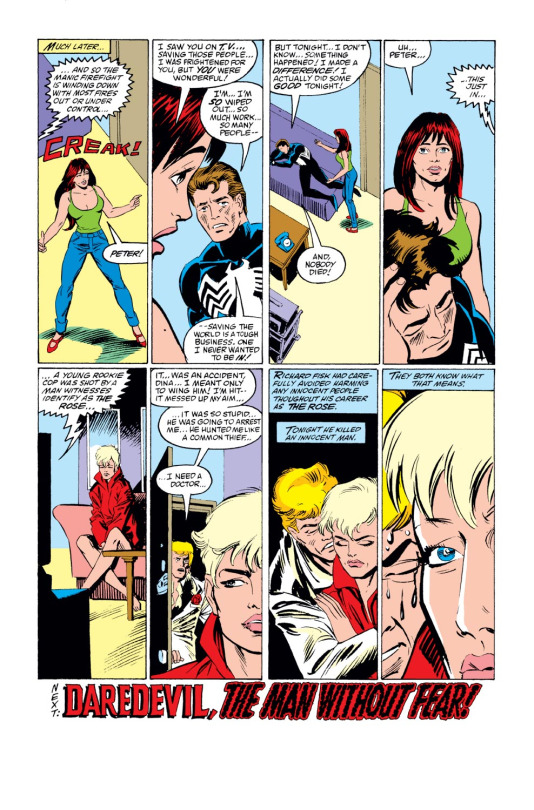
This incident, being unique even amidst MJ’s unique life, would stick out in her memory.
It’s a huge lesson for MJ about the horrible consequences of lying to him about potential criminal activities. Noticeably in this situation MJ knew criminals were simply going to meet up and talk to one another, which isn’t (to my knowledge) actually a crime unto itself. And yet in AMJ #1 Mysterio and his crew collectively are actively committing various crimes (evading the law, identity theft, fraud, etc.) but MJ still lies about them.
The other example where MJ lying had horrible consequences is admittedly much more contentious. During Howard Mackie and John Byrne’s run on both ASM v2 and Peter Parker: Spider-Man v2 they initiated two subplots regarding Peter and MJ lying to one another. In Peter’s case he lied to Mary Jane about resuming his role as Spider-Man following his seemingly permanent retirement.
In MJ’s case she lied to Peter about a mysterious stalker who had begun making threatening phone calls to her. The stalker aggressively professed ownership of her and also threatened Peter. MJ presumed (for some reason?????) that the stalker was one of Peter’s enemies and thus kept him in the dark in order to protect him and maintain the normal life she believed they had. I admit this doesn’t make much sense but that’s a discussion for another time.

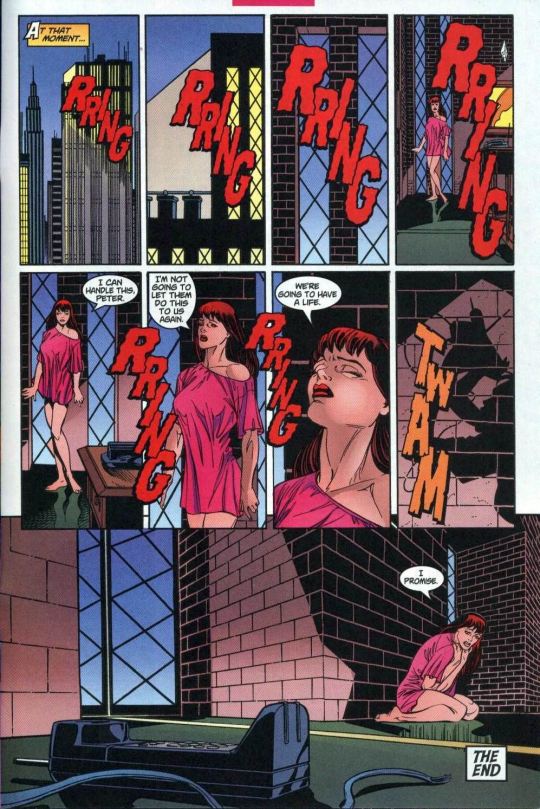

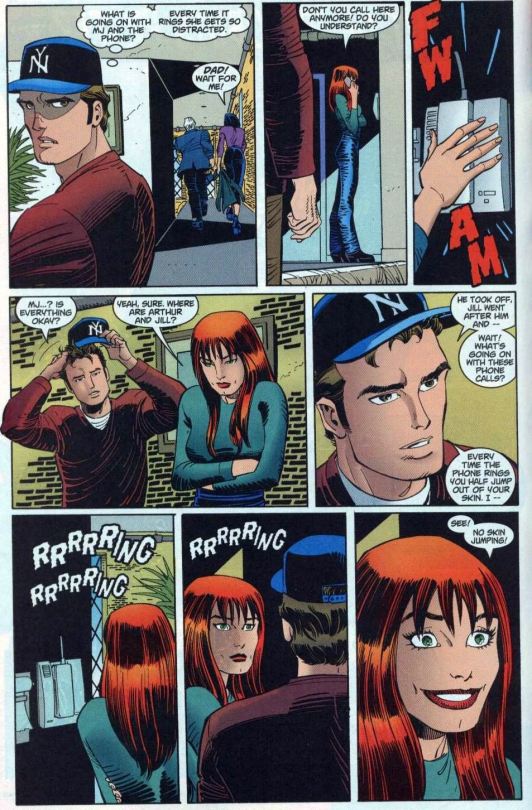

These lies (from both parties) majorly contributed to a creating a big schism in Peter and MJ’s marriage. They also, obviously, harmed MJ’s mental and emotional health through scaring and upsetting her, rendering her terrified of the phone.
MJ’s upset and horror at the situation escalated when her stalker went from threatening phone calls to invading her workplace to leave similarly threatening written messages.

This was very quickly followed by more violent acts like the stalker triggering explosions in the road where MJ’s limo was driving. It is implied several cars are totalled in the explosions, potentially injuring or killing innocent people and leaving MJ’s friend Jill Stacy scared and potentially mentally traumatised.
By this time Peter and MJ had independently learned they were deceiving one another. Peter rescued MJ from the stalker’s attack prompting the couple to briefly argue over their deceptions. It was clear that during this argument they held one another in poor favour for never fessing up, further damaging their marriage.

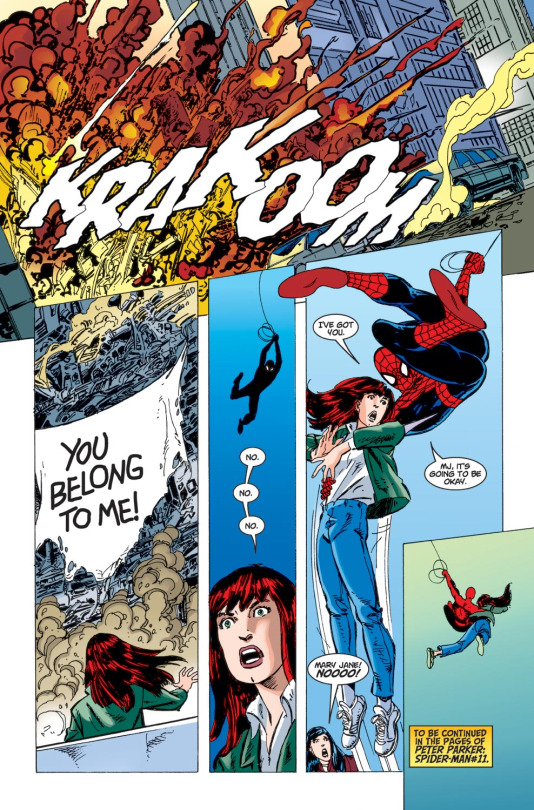
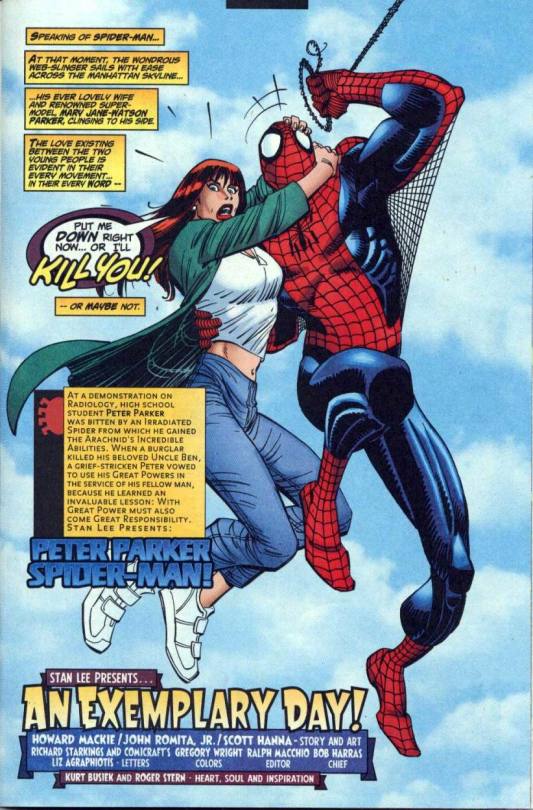

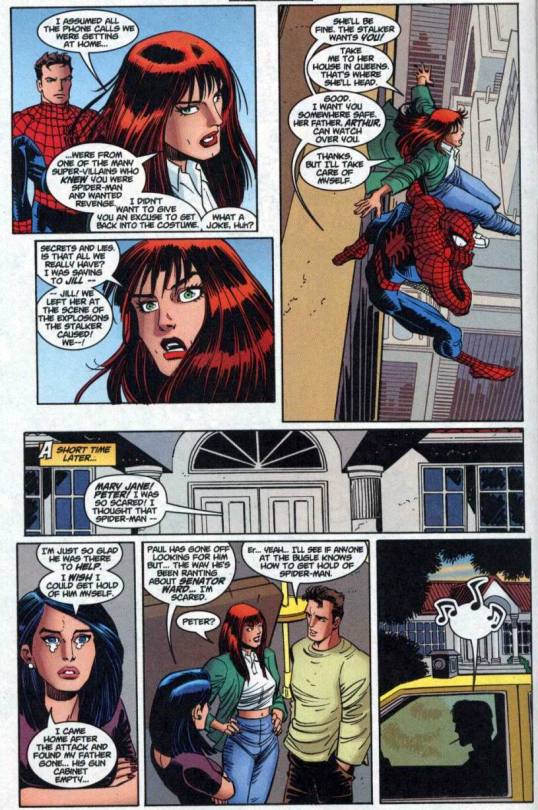
Not long after MJ’s stalker escalated things again, this time by causing various bombings near MJ’s home and around the city. He even publicly announced he was doing it to ‘have’ Mary Jane and that more attacks would follow. The situation became so serious that the authorities became involved and confirmed that there were innocent casualties resulting from the bombings.
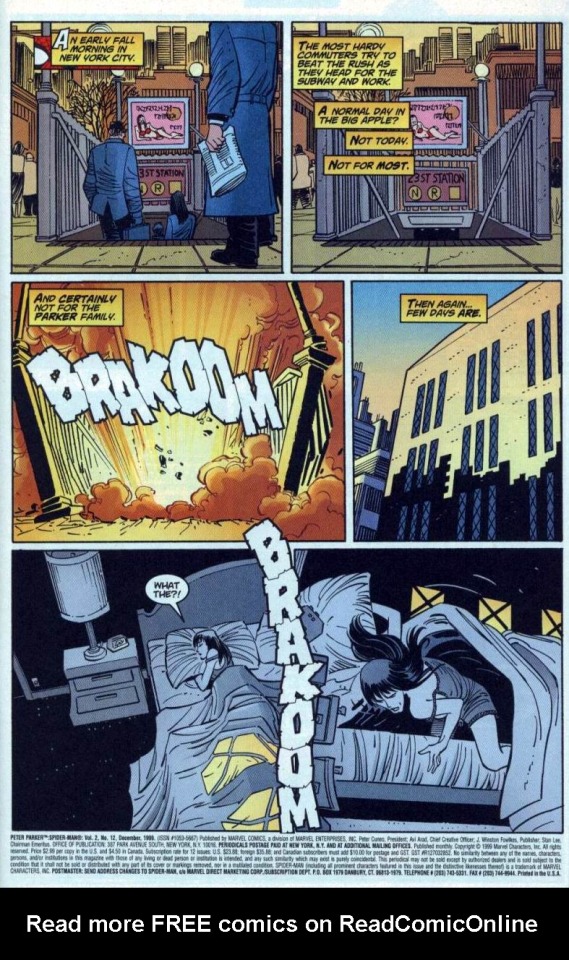
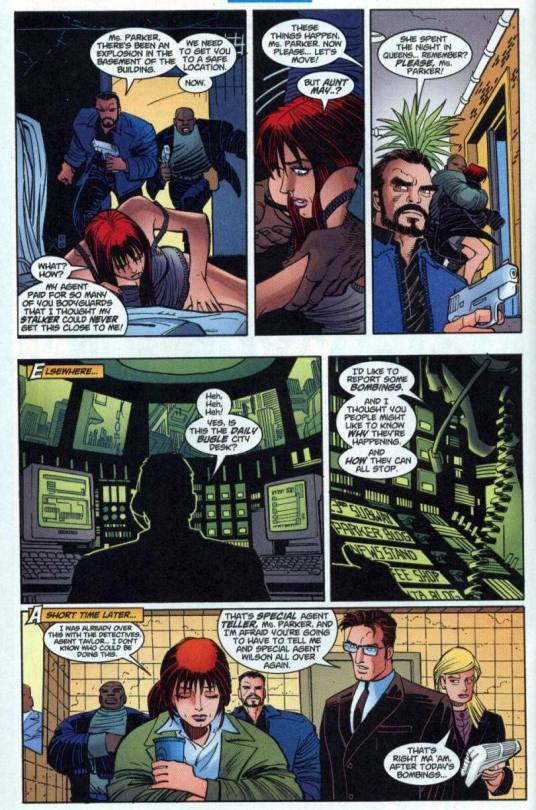

The stalker was so extreme though he even attacked the police station MJ was being kept at for her safety, injuring yet more people and prompting MJ to flee for her life.

Unbeknownst to her, the stalker, posing as a cab driver, picked her up. MJ realized the truth when the stalker took her to the Bugle and locked the doors. Revealing another bomb counting down, he began to ramble about ‘proving his love’ to her and made moves to touch her. MJ escaped and yelled for civilians to clear the area. She escaped just in time as the cab exploded, seemingly killing the stalker.



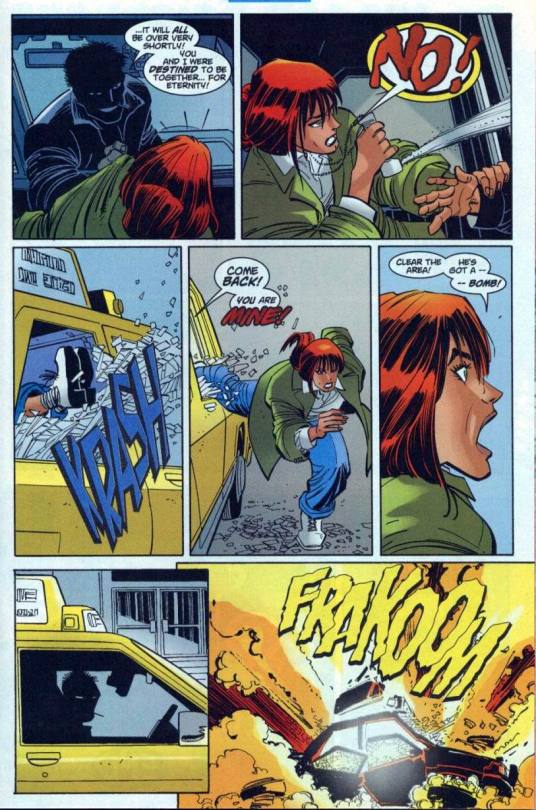

Obviously such an experience would be upsetting enough, but it got worse because the stalker wasn’t actually dead!
When MJ boarded a plane the stalker (posing as a civilian) drugged her, took her off the plane, then faked her death by causing the plane to explode mid-flight and murdering everyone on board.
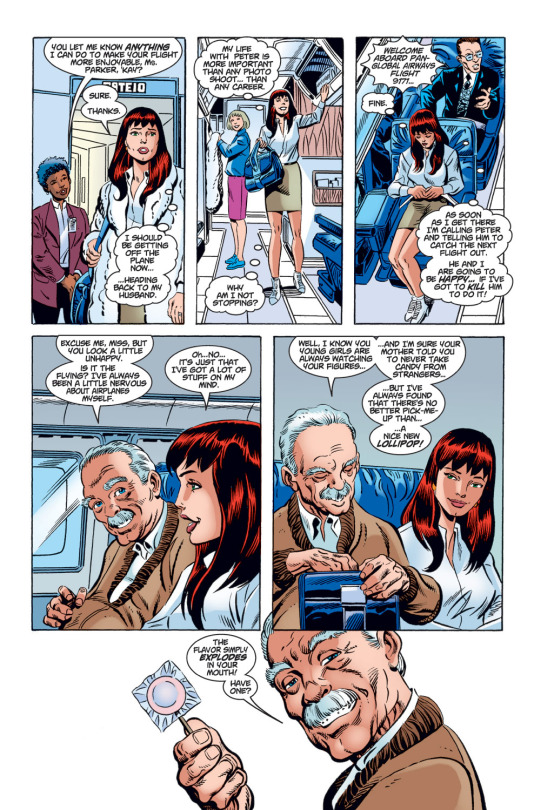

The stalker then held Mary Jane prisoner for six months. It was implied that in that time she was confined to a singular room. Even if that wasn’t strictly speaking the case it was confirmed that in all that time MJ was totally denied human contact, the stalker not even talking to her.
She was driven to such desperation that she practically begged her captor to just speak to her. When he did she exclaimed her thanks to him in spite of the situation.
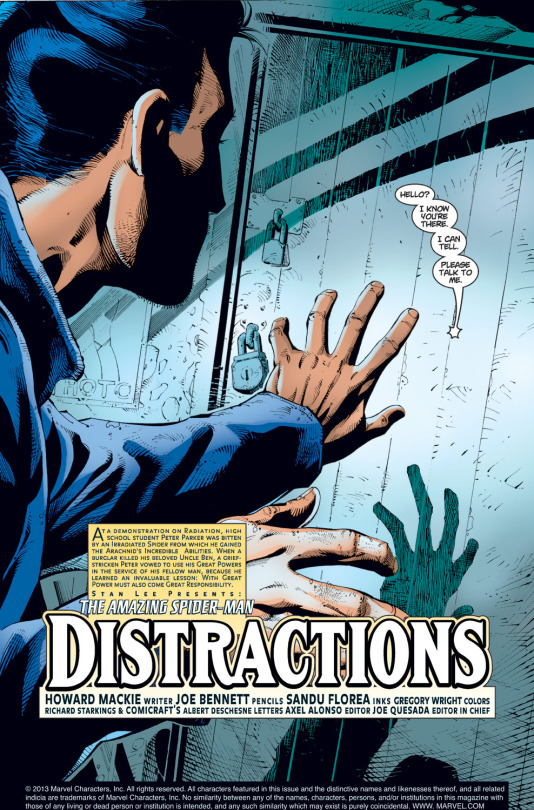



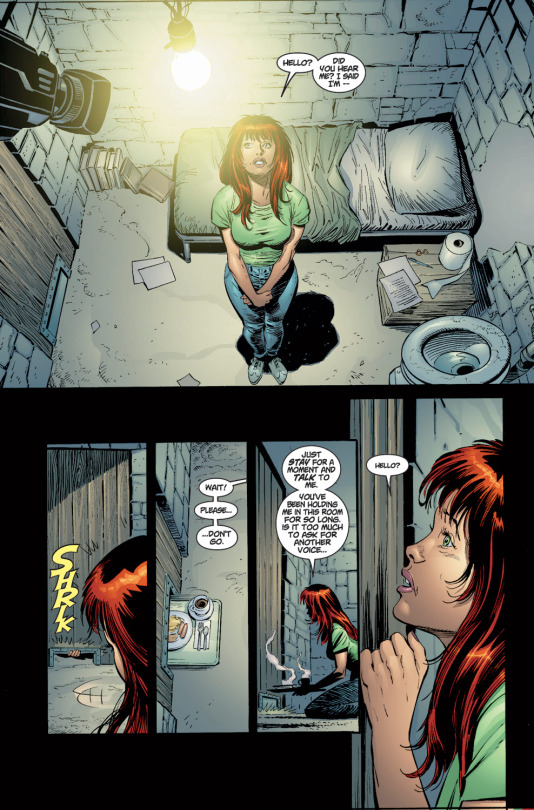

After this the stalker revealed the details of his origin, motivations and plan (which aren’t really relevant right now). These details horrified MJ, none more so than the revelation that he killed everyone on her plane and that Peter was the stalker’s real target.

When Peter showed up the stalker used his psychic abilities to place MJ into a coma, one that would’ve been permanent had he not died shortly thereafter.


MJ barely survived and was seemingly intent upon restarting her normal life. However, she was left (temporarily) traumatised by the experience. She was frightened of phones when they rang and practically had a panic attack when the door to the attic wouldn’t easily open.





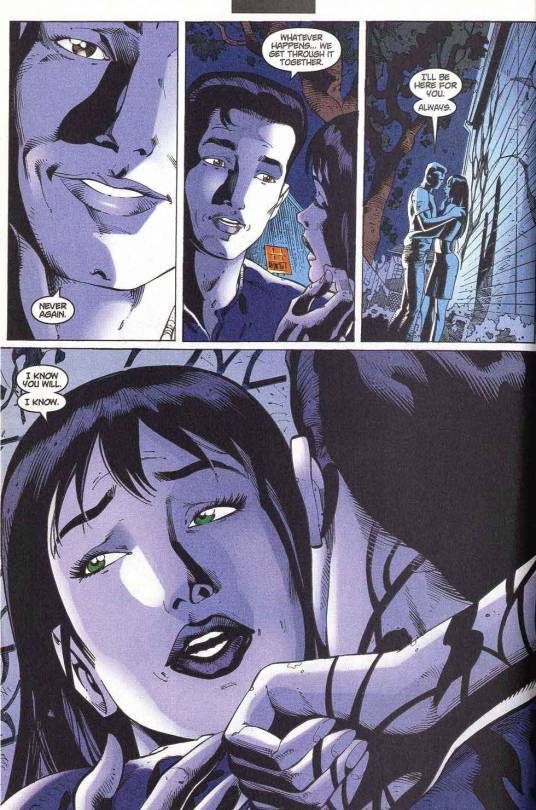
In part due to this trauma MJ opted to separate from Peter, eventually heading out to L.A.
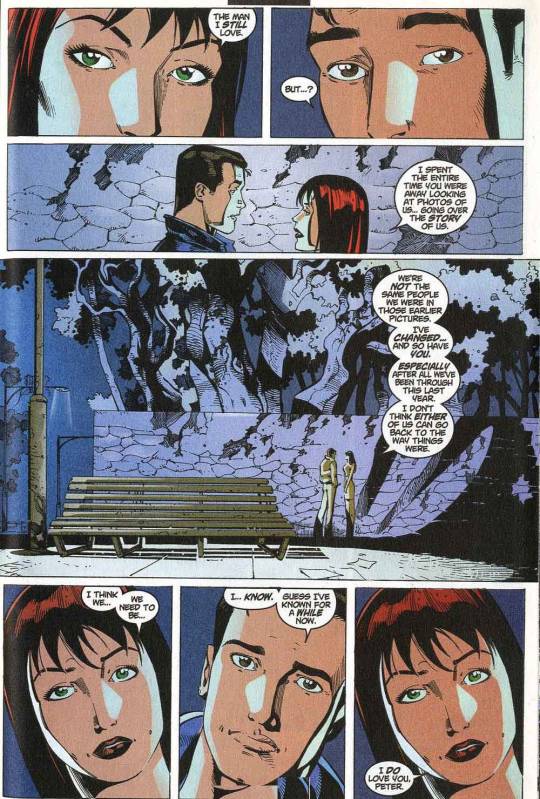
In a much later story MJ would reflect that the time they were separated was one of the worst in her life.

The entire saga of the stalker…well actually it doesn’t make sense.
For various reasons Peter and MJ simply would never have lied to one another in the first place. Even excusing this many of their actions within that context didn’t add up.
Nevertheless it provided the foundation that later (much better) Spider-Man stories built off of and nevertheless provides at least food for thought.
Those thoughts being how the experience clearly illustrated to MJ that she made a mistake in lying to Peter.
Innocent people, her friends, her family and her husband, were physically, mentally or emotionally harmed by her stalker and her 'death'. At the very least the passengers on her plane lost their lives, though other victims of the stalker’s bombings might also have died.
MJ herself suffered a shitton of harm and emerged from the events with outright PTSD.
ALL of this likely would’ve been avoided if Mary Jane had simply told Peter or the authorities about the phone calls earlier than she did.
Whilst Mysterio and his crew might not do anything as bad to her as the stalker, it’s all too possible that they could harm someone if remained unchecked. And lying to her romantic partner is a HUGE part of enabling them to remain unchecked!
Not to mention on the most basic of levels, lying to your romantic partner is 9/10 simply bad for any healthy romantic relationship. Indeed, the stalker saga illustrated that in it’s own clumsy way but its just common sense. Outside of exceptional circumstances couples should be honest with one another. Peter has to routinely lie as a matter of practicality and yet even he knows that in general it’s something that should be avoided, as evidenced by ASM #310.

I’m not saying there aren’t times where withholding the truth is ultimately the best option for everyone involved but AMJ is obviously not one of those times. There is a huge difference between MJ deciding to not mention that she was briefly tempted to sleep with another man when nothing actually happened...

…verses not telling him the guy who faked his Aunt May’s death is walking free.
One avoids awkward or hurtful feelings in a romantic relationship. One potentially seriously endangers innocent people.
There is a counterargument to all this though. Couldn’t MJ be lying out of concern for Peter?
Answer: Definitely not. But that’s a topic big enough to justify it’s own instalment.
P.S. I am aware MJ has at times lied to Peter about other things. But my point is there is a huge difference between a little white lie or a lie that is intended to not rock their marital boat (e.g. not telling him about Jason Jerome) compared to potential life and death stuff like the above or AMJ #1.
Previous Part
Next Part
Master Post
#Amazing Mary Jane#Leah Williams#Peter Parker#Spider-Man#mjwatsonedit#mary jane watson#Mary Jane Watson Parker#MJ Watson#Mysterio#Quentin Beck
14 notes
·
View notes
Text
Historian out
Another DAH defection.
There was yet another shakeup in staff at the Department of Arkansas Heritage last week, prompting a former DAH director to call for the resignation of Director Stacy Hurst and causing members of the Black History Commission to wonder if they're next on Hurst's chopping block.
State Historian Lisa Speer, director of the Arkansas Archives, resigned Feb. 6. "I felt like I had come to a point in my position where I was not able to function effectively as the leader anymore," she told the Times. "I was not sure I had the confidence of the administration at Heritage to carry out my responsibilities without question and intervention and a lot of oversight.
She said much the same thing in her letter of resignation to the department. "You cannot need and use people for the benefit of the department, while disrespecting and questioning their judgment at every turn," she wrote Hurst and Deputy Director Rebecca Burkes. "With the 2016 transition to the Department of Heritage, there has been no guidance, no mentoring, and no support that ultimately did not benefit the agenda of promoting the Department of Heritage at the expense of the 'divisions' within it. The mass defections of staff over the last several years clearly illustrate the failure of leadership, as does the need to bring in outside consulting firms to conduct staff surveys and focus groups to diagnose the causes of internal dysfunction."
In a response to the letter released to the press, Hurst wrote, "I regret that Dr. Speer chose to abandon her post and her staff with no notice and in such an acrimonious way." Hurst noted that the DAH had "experienced a great deal of change over the past three years including a new administration, a move to new offices after 25 years in one location, a new focus on managing for efficiencies, and the addition of a division. ... Changes have been made to centralize administrative management in order to perform more efficiently. We have experienced typical staff turnover like any other agency, but also enjoy many long-term, fantastic employees who are passionate about their work."
When Speer was hired in 2013, the Arkansas Archives operated as the Arkansas History Commission, under the aegis of the Department of Parks and Tourism. It was overseen by an independent commission, which hired Speer. (Like the Arkansas Game and Fish Commission, the agency itself was both titled a commission and governed by a commission). But in 2016, at the bidding of Governor Hutchinson, the agency was moved to the DAH and the History Commission was stripped of its authority. The move came under fire from historians who were concerned about the effect the move would be on the archives, housed in special facilities in the Big Mac building behind the Capitol. The DAH's new office building, which it moved into in 2017, was not designed to accommodate the archives.
Hurst said last week that because the archives were now at the DAH, it was getting conservation tax revenue it had not previously received. However, as an agency of the Department of Parks and Tourism, it would also have been supported by the conservation tax, a 1/8 cent divided by the DAH (9 percent), Parks and Tourism (45 percent), Game and Fish (45 percent) and the Keep Arkansas Beautiful Commission (1 percent). Also, the archives did not receive conservation funding for fiscal year 2018, though the DAH did direct funds to a record salvage operation in Howard County. Department spokeswoman Melissa Whitfield said the DAH would ask the legislature for $200,000 in conservation funds for the archives in the coming fiscal year.
Tom Dillard, the retired head of special collections at the University of Arkansas and a former director of the heritage department, said he wanted to meet with others in the history community to discuss the archives situation and was calling for Hurst to resign. "Stacy Hurst has never enunciated any guiding principles about how she sees her job or what her goals are for the future," Dillard said. "I think we've seen enough of Stacy Hurst. ... If the governor will not ask for her resignation, then we need legislation to transfer the History Commission back to Parks and Tourism."
The University of Arkansas's history listserv has been buzzing with criticism of the move and the job advertisement for Speer's successor. When Speer was hired, the Commission required that the State Historian "must demonstrate extensive knowledge of Arkansas history, archival management, principles, modern archival/curatorial processes ... . Requires earned doctorate in history from accredited higher education institution or equivalent as determined by the commission." Speer has a Ph.D. in American history from the University of Mississippi, where she was curator of the Mississippi Collection in the archives and special collections. As the state historian, she was paid $89,636. The advertisement for Speer's replacement lists no archival experience and says only that a doctorate in history is "preferred" but the only required degree is a bachelor's in public administration, business administration or a related area and five years' experience in those areas. Knowledge and skills required are fiscal, management of personnel and fund-raising. The pay is listed as $62,531 to $90,670 a year.
Speer is the most recent in a number of employees who have left under Hurst's management. The DAH has also lost longtime Historic Preservation Director Missy McSwain; McSwain's successor, Interim Director Marian Boyd, who had worked at the DAH for 25 years; Historic Preservation Deputy Director Patricia Blick; archeologist Bob Scoggin, who ran afoul of Hurst while working on an archeological site now beneath the DAH parking lot; Delta Cultural Center Director Katie Harrington; Mosaic Templars Cultural Center Director Sericia Cole; and former deputy DAH directors Kathy Holt and Marynell Branch. Most had worked under both Democratic and Republican administrations.
Members of the Black History Commission — an independent commission with a small budget that works with the state archives, awards grants under the Curtis H. Sykes Memorial Grant Program and hosts events — have been concerned that, like the Arkansas History Commission, they face a downgrade. Chairman Carla Coleman asked to meet with Governor Hutchinson last week to "let him know we are trying to be good stewards. We are not just an advisory board," she said, though that is how Hurst has characterized the commission in talks with Coleman.
Coleman and the commission have butt heads with Hurst twice: first, when Coleman complained that the DAH ordered the Mosaic Templars Cultural Center, which is overseen by the agency, to stop selling #blacklivesmatter T-shirts, and more recently, when Coleman took issue with the fact that Hurst insisted the Black History Commission logo be removed from the advertisement of a Feb. 3 workshop, "African Americans in Arkansas's Rural History," at Mosaic Templars. According to Coleman, Hurst said the logo made the poster too busy.
It is perhaps telling of Hurst's management style that she chose to be involved with an advertisement for a one-time event sponsored by the commission. It was at the Feb. 3 event that Coleman was told that Hurst was "coming after y'all; you need to pay attention," Coleman said. Hurst told Coleman that was not the case after their meeting with the governor.
Historian out
0 notes
Photo

Catholic Physics - Reflections of a Catholic Scientist - Part 60
Faith as a scientist; Faith as a Catholic
Story (with images on linked page):
https://www.linkedin.com/pulse/catholic-physics-reflections-scientist-part-60-harold-baines/?published=t
Est autem fides credere quod nondum vides; cujus fidei merces est videre quod credis St. Augustine, Sermones 4.1.1 - Illustration from Brainy Quotes. (Caption for image on linked page)
"Anybody who has been seriously engaged in scientific work of any kind realizes that over the entrance to the gates of the temple of science are written the words: 'Ye must have faith.' It is a quality which the scientist cannot dispense with." Max Planck, Where is Science Going? p.24
"Now faith is the substance of things hoped for, the evidence of things not seen." Hebrews 11:1
"Science and religion are two windows through which we can look out at the world around us." Freeman Dyson, Infinity in All Directions
INTRODUCTION--WAYS OF KNOWING.
My recent post about Intelligent Design prescribed what science should and should not be. To extend this discussion, I would argue that faith is required to do serious science (as the quote from Max Planck suggests); thus, contrary to what evangelical atheists say, faith is an attitude not restricted to the religious.
A useful preliminary to such a proposal would be a discussion about ways of knowing, what philosophers term epistemology. We'll only do this briefly since this post is not a philosophy text. For a more extensive coverage, please use the references listed below and the links.
From Seth Godin's web site. (Caption for image on linked page)
DEDUCTION -- CLASSICAL LOGIC.*
One way of knowing is deduction, drawing conclusions from premises we believe to be true, using logical procedures first set up by Aristotle -- going from the general to the specific. Here's an example (with apologies to Gelett Burgess), a "syllogism":
Major premise: All cows are purple.
Minor premise: This animal is a cow.
Conclusion: This animal is purple.
If you know the premises to be true, then the conclusion is true. If the premises aren't true (as in this example), then the conclusion may or may not be true. For example, you could paint a cow purple, or it could be a mutation.
Note the difference between the above and the following:
Major Premise: All cows are purple.
Minor Premise: This animal is purple.
Conclusion: This animal is a cow.
The conclusion clearly need not follow; there might be purple animals other than cows (unless the premise were stated "Only cows are purple"). This type of false logic (fallacy), would be "affirming the consequent".
INDUCTION.
Induction is generally regarded as proceeding from particular instances or events to a general conclusion. (I'm not referring in this context to the mathematical method of proof.) Here's an example. A bee-keeper notices that bees move up and down in a special way -- "dance" -- after they have been gathering nectar from a certain group of flowers. The dance is the same for a given group of flowers. The bee-keeper concludes that this bee-dancing is a communication to other bees about the location of the flowers and receives a Nobel Prize. (We'll see below that science is generally more than collecting data and making inferences.)
ABDUCTION
Abduction is reasoning from a set of present facts to a possible explanation -- events in the past that would account for the facts. I've discussed this in my post on Intelligent Design, so I'll refer the readers to that discussion
THE SCIENTIFIC METHOD
Ask a scientist "what is the scientific method?", and you're likely to get a blank stare or, "Am I on Candid Camera?" as a response. If you ask a philosopher, you're may get any one of a number of answers, depending on whether the philosopher belongs to the "realist" or "anti-realist" camp. There are philosophers who argue that there are no "laws of nature", but that scientific theories are models proposed only "to save the phenomena". (See my post, Tipping the Sacred Cow of Science -- Confessions of a Science Agnostic.)
I'm not going to expound on all the various philosophical schemes for how science works, but focus on one that I believe most closely corresponds to science as it's practiced. I'll use a tree as a representation of how science proceeds, and do so with a word diagram, rather than a picture since I'm not an artist:
SOIL: The universe is orderly and intelligible.
ROOTS (specific assumptions about scientific principles): Symmetry / Conservation Principles; Uniformity (Cosmological) Principles; The Second Law of Thermodynamics; Microscopic Reversibility; replicability and predictability of observations.
TRUNK (The sap carried is methodology: measurement, observation, mathematics).
MAIN BRANCHES (divided into basic theories): Quantum Mechanics; General and Special Relativity; "Classical" Electromagnetism; Classical Mechanics; Thermodynamics; Super-String Theory; etc.
SUBSIDIARY BRANCHES (e.g. for Quantum Mechanics): Quantum Electrodynamics; Laser Optics; Magnetic Resonance; The Standard Model; Molecular Structure; Solid State Theory; Super-conductivity; etc...
As you'll note, sciences other than physics are neglected in this scheme -- I could add chemistry, but I don't know enough about biology, geology, etc. to include them, so add on dear reader, if you're knowledgeable.
A few explanatory remarks are in order. First, it is not a novel idea that faith in an orderly and intelligible universe is the soil in which the tree of science grows. A justification for this notion is that the enterprise of science grew in a Medieval Civilization, and only in this milieu; and that this civilization held the Judaeo-Christian premise that God ordered the universe to be meaningful -- "The Heavens declare the glory of God" (Psalm 19a). Pierre Duhem, Fr. Stanley Jaki and Dr. Stacy Trasancos have written about how science was born of Christianity, and not in other civilizations. Although the works of science confirm the notion that the universe is orderly and intelligible, they do not prove it to be so; that a scientist does believe it to be so is a matter of faith, and if he/she did not have that faith, why should he/she continue the exhausting effort of probing the mysteries of the universe? Can anyone point out a great or even good scientist who did not believe this?
Second, the roots of the tree of science, its basic principles, are again matters of faith. They seem to be reasonable and confirmed empirically, but there is not logical justification for them -- they are premises, not conclusions. There is an equivalence between symmetry restrictions and physical laws, shown by Emmy Noether in the early 20th century: for example, spherical symmetry yields conservation of angular momentum; symmetry under time reversal (t -- > - t ) yields conservation of energy. It's interesting that a symmetry thought before 1954 to hold universally, parity (mirror-image symmetry), was shown not to stand by itself, but to be incorporated into CPT symmetry (charge conjugation, parity and time reversal).
There are also esthetic judgments made about theories, judgments that are not considered here. Such judgments are also articles of faith -- that a theory that is "elegant" is to be preferred to one which is long and involved. See my post God, Symmetry and Beauty in Science II for non-elegant thoughts on this.
MY FAITH AS A CATHOLIC
The picture I'll give as the structure of my Catholic belief, a tree analog, will be unorthodox but, I hope, not heretical. It will reflect my faith as it has developed during and since my conversion.**
SOIL: The Trinity -- God, the Father, above us; God, the Son, beside us; God, the Holy Spirit, within us.
ROOTS: Dogma and Doctrine: The Incarnation, The Passion and Resurrection, the Immaculate Conception, The Eucharist & Transubstantiation, Apostolic Succession, the Primacy of Peter as Bishop of Rome; the Seven Sacraments, Scripture.
TRUNK: The Church
BRANCHES: Liturgy, Theology, Sacred Orders -- religious and lay, the Sacraments in Parish Life, Missionary Life, Prayer and Devotion.
I'll admit that this representation is, perhaps, forced in order to make a comparison with the enterprise of science. Nevertheless, there is a bedrock of faith, a soil--a belief in the Trinity Godhead--that nourishes my religious beliefs, and it is true that dogma and doctrine are the roots of my Catholic faith. I invite the reader to draw his/her own tree of belief.
*Additional material on Deduction:
Charles Dodgson (better known as Lewis Carroll, author of the Alice books), an Oxford academic, gave us many amusing and complicated puzzles that mixed his love of nonsense and logic. Some of Carroll's logical puzzles were exceedingly complicated, involving many statements and logical variables. Notable among these is the "Pork Chop Problem", which has 15 statements and 11 logical variables. The solution to such is not easy, and computer methods are helpful. It may be difficult to make sure that none of the statements are contradictory, so that no paradoxes will occur. To this end, there is a discipline,"satisfiability theory", in mathematical logic.
From a series of articles written by: Bob Kurland - a Catholic Scientist
0 notes
Photo

Catholic Physics - Reflections of a Catholic Scientist - Part 42
Galileo redux: When should the Church meddle in science?
“Do not meddle in the affairs of wizards, for they are subtle and quick to anger.” J.R.R. Tolkien, The Lord of the Rings
"Science can purify religion from error and superstition; religion can purify science from idolatry and false absolutes. Each can draw the other into a wider world, a world in which both can flourish." St. John Paul II, Letter to Rev. George Coyne, S.J., Director of the Vatican Observatory.
The spur for this post is, of course, the rumor that Pope Francis is about to issue an encyclical proposing that we in the Church get on the AGW bandwagon (Anthropic Global Warming). My views on AGW are given in a post on this blog, Scientific Integrity: Lessons from Climategate), so I don't propose to debate that issue extensively here. Rather, I should like to put a more general question: what science should the Church pronounce as correct, and which should be left to the scientists.
HISTORICAL INTRODUCTION
Let me state at the beginning that I'm with Fr. Stanley Jaki and Stacy Trasancos, that science is the child of Medieval Christianity, that belief in a rational universe ordered by God and the devotion of Catholic religious and lay scholars (Roger Bacon, Albertus Magnus, Jean Buridan, Copernicus...) laid the foundations for Galileo and Newton, who each believed in a Divine order that man could understand.
The split began in the Renaissance, with the condemnation of Galileo and his house arrest. The issue nominally involved in his arrest, whether his support of the heliocentric hypothesis contradicted Scripture, was complicated by the politics of Church leaders in the Holy See and by attempts to counter the effects of the Reformation. I've discussed this in another post, in which links and references are given to the historical context of Galileo's condemnation.
SAINT JOHN PAUL II'S INTERACTION WITH SCIENCE
The Church's error in condemning Galileo was recognized by St. John Paul II, who made an apology and an explanation of the error. (This was just one of St John Paul II's efforts to effect a rapprochement of the Church with science. ) A lesson to be learned here is that there need be no conflict between the teachings of the Church and science even though the Church should be knowledgeable about science that relates to ethical and moral issues intrinsic to Church teaching.
The ideal of Church/Science interaction is illustrated by St. John Paul II's message to the Pontifical Academy of Sciences on evolution:
"...some new findings lead us toward the recognition of evolution as more than an hypothesis....What is the significance of a theory such as this one? To open this question is to enter into the field of epistemology. A theory is a meta-scientific elaboration, which is distinct from, but in harmony with, the results of observation. With the help of such a theory a group of data and independent facts can be related to one another and interpreted in one comprehensive explanation. The theory proves its validity by the measure to which it can be verified. It is constantly being tested against the facts; when it can no longer explain these facts, it shows its limits and its lack of usefulness, and it must be revised [emphasis added]
...And to tell the truth, rather than speaking about the theory of evolution, it is more accurate to speak of the theories of evolution. [emphasis added] The use of the plural is required here—in part because of the diversity of explanations regarding the mechanism of evolution, and in part because of the diversity of philosophies involved. There are materialist and reductionist theories, as well as spiritualist theories. Here the final judgment is within the competence of philosophy and, beyond that, of theology.
The magisterium of the Church takes a direct interest in the question of evolution, because it touches on the conception of man, whom Revelation tells us is created in the image and likeness of God. [emphasis added]... In other words, the human person cannot be subordinated as a means to an end, or as an instrument of either the species or the society; he has a value of his own. He is a person. By this intelligence and his will, he is capable of entering into relationship, of communion, of solidarity, of the gift of himself to others like himself... if the origin of the human body comes through living matter which existed previously, the spiritual soul is created directly by God ("animas enim a Deo immediate creari catholica fides non retimere iubet"). (Humani Generis)
As a result, the theories of evolution which, because of the philosophies which inspire them, regard the spirit either as emerging from the forces of living matter, or as a simple epiphenomenon of that matter, are incompatible with the truth about man. They are therefore unable to serve as the basis for the dignity of the human person. [emphasis added]. St. John Paul II, Message to Pontifical Academy of Science, 22 Oct. 1996.
What a fine example! St. John Paul II shows that he knows what science is about, that it requires empirical confirmation of hypotheses. Unlike many scientists, he distinguishes the scientific fact of evolution, the descent of species, from theories/mechanisms used to explain evolution (e.g. the neo-Darwinian model). And most important, he shows why and how the Church should be concerned with theories that impinge on its teachings. We cannot accept theories which "regard the spirit either as emerging from the forces of living matter, or as a simple epiphenomenon of that matter".
WHEN THE CHURCH SHOULD NOT PRONOUNCE ON SCIENCE
When should the Church not make judgments on scientific matters? Clearly if the science itself is not settled, Church dignitaries should carefully consider whether it is necessary that they support one of contending interpretations. Cardinal Schonbrun caused much controversy by publishing an essay in the New York Times, "Finding Design in Nature", that seemed to support the theory of Intelligent Design as opposed to the neo-Darwinian mechanism of evolution. The essay was criticized by a number of Catholic scientists, including the then director of the Vatican Observatory, and Stephen Barr in an article in First Things. (By the way, in his article I'm not sure that Barr makes the same distinction that Pope John Paul II did, between the facts of evolution, and the theories proposed for the mechanism of evolution.) Cardinal Schonbrun enlarged on his position in a later article in First Things to explain that he was not necessarily supporting Intelligent Design theory, but that God guided all events, including evolution, and that our universe is not the product of chance. And we all certainly agree with that opinion.
I'm very much afraid that Pope Francis is about to repeat the mistake made by Cardinal Schonbrun by taking an official Church position for the truth and perils of Anthropic Global Warming. I don't know what will be in the proposed Encyclical, but if it is based on statements in his interviews and from the article from the Pontifical Academy of Sciences and the Pontifical Academy of Social Sciences, there will be judgments and statements that are contentious, that are not held by all scientists. For example, it is not the case that polar ice and Himalayan snow are decreasing (they melt, as ice does, but the net amount is not decreasing due to global warming--see evidence from satellite images.) (For a harsh critique, see the PowerLine post by John Hinderaker; for a more charitable and hopeful view of the upcoming encyclical see the post by Matt Briggs.)
As I said above, I don't propose in this article to debate extensively the merits of AGW. On the other hand, it is essential that two points be made.
First, it is not true that a "97% consensus" of scientists support the AGW / Climate Change proposition. See, for example the 97% myth. And in any case, scientific theories and propositions are not judged by majority vote, but by empirical confirmation. Before the Michelson-Morley experiment a majority of scientists believed in the ether as the medium for propagation of electromagnetic waves; afterwards, not many.
Second, the extent of data massaging ("fudging") revealed in the Climategate excerpts and (more recently) of fiddled temperature data from Paraguayan weather stations should cause one to regard reported temperature increases with more than usual skepticism.
Accordingly, unlike evolution, global warming caused by human production of CO2 is by no means a settled scientific issue.
I'll not discuss at length the unintended consequences for the poor of measures taken by governments to combat the threat of AGW, but only mention a few:
rising food costs for third world populations due to diversion to biofuels;
replacement of rain forest by palm tree groves for biofuels;
the loss of jobs by coal miners and utility plant workers;
the risk of pollution by elements used in wind turbines and hybrid automobile batteries (there is a greater carbon footprint from mining lithium and shipping batteries than in the corresponding use of gas fuels);
the despoilation of landscapes and loss in property values due to wind turbines;
the decimation of migrant bird and bat populations by wind turbines;
For a fuller account see Andrew Montford's "The Unintended Consequences of Climate Change Policy". The Danish statistician/economist, Bjorn Lomberg, believes in AGW but also believes that resources used to deal with it would be better expended for the Third World poor by improving water supplies, agricultural resources and dealing with disease.
HOW THE CHURCH SHOULD DEAL WITH SCIENCE
The ideal is illustrated by St. John Paul II's efforts (see above) and the Church's stance on questions dealing with bioethics. In bioethical issues, it is the Church's position on the sanctity of life and the uniqueness of the human person created in the image of God that determines Her position on abortion, euthanasia and the use of human embryos for stem cell research. The biomedical science is settled; the point is whether the technology arising from the science should be used. An area in which confusion might arise is that of genetic modification of humans: the position of the Church is that genetic modification for therapy--to cure a genetically induced disease--is permissible but not for enhancement, not to create the "supermensch"; see "Human or Superhuman?"
How the Church deals with bioethical questions is a different thing from whether the Church should pronounce a scientific theory true. The Church has not said that one of the 17 or more interpretations of quantum mechanics is correct. She has not said that the Big Bang hypothesis is correct, even though it was suggested by LeMaitre, a Belgian Abbe and is consistent with the Church's teaching of Creatio ex Nihilo.
If it is indeed necessary that the Church, in the person of the Holy Father or other ecclesiastical authority, gives an edict on the truth or falsity of a scientific theory, it should employ the same standards of rigor as it does in the canonization process, when it employs a Devil's advocate to decide whether miracles due to the intervention of a saint have occurred.
REFERENCES
Climate Change: The Facts. A collection of articles by various authors including Delingpole, Lindzen, Watts.
BioMedicine and Beatitude; an Introduction to Catholic Bioethics. Nicanor Austriaco, OP
From a series of articles written by: Bob Kurland - a Catholic Scientist
0 notes